Chapter Two
Second World War
The Salmon- and Sargo-class fleet submarines would prove very popular with the US Navy submarine community and they confirmed that the decision to settle on a submarine class of approximately 1,500-ton displacement was the correct choice. With the design parameters set, the US Navy commissioned more than 200 examples of very similar fleet-class submarines between 1939 and 1945. These were divided into five classes: the Seadragon, Tambor, Gato, Balao and Tench.
Seadragon Class
The Seadragon-class submarines, near-identical copies of the Sargo class, were commissioned following the official beginning of the Second World War, the first of these in October 1939 and the last in December 1939. Their hull classification numbers ran from SS-194 to SS-197.
All four examples of the Seadragon class had a diesel-electric-drive propulsion system with high-speed electric motors powering their engines via reduction gears. It was this now mature diesel-electric-drive propulsion system that became standard on all subsequent US Navy submarine fleet classes through the Second World War, as well as those of the early Cold War period.
With a surfaced displacement of 1,450 tons, the Seadragon-class submarines had a length of 310ft 6in with a pre-war crew complement of fifty-five that rose to seventy-eight men during the Second World War. The rise in the number of crewmen on board the submarine during the Second World War also occurred with other prewar US Navy fleet submarines that saw service in the conflict.
Tambor Class
Commissioned between June 1940 and June 1941 were twelve examples of the Tambor-class submarines, a refined version of the previous Sargo- and Seadragon-class submarines with a crew of sixty. The Tambor class’s most significant departure from all previous classes’ armament was six internal bow torpedo tubes rather than four. This supported more shots without reloading, as well as stowage for two more torpedoes. Complementing the six in the bow were four stern tubes, a feature first appearing on the AA-1 class.
End of the Line
Decommissioning of any US Navy vessel does not automatically imply the end of its active service life. Sometimes decommissioned vessels are placed into storage only to be removed at a later date and re-commissioned. Sometimes this process can occur more than once. When decommissioned for the final time all US Navy vessels are stricken from the inventory rolls. Only after this takes place can a US Navy vessel be sold for scrapping, although a few might end their careers as targets and a very few as museum ships.
Another weapon first appearing on the Tambor class and available for deployment from all following fleet submarine classes were two underwater mines that deployed from the boat’s torpedo tubes. Their designations were the Mk. 10 and Mk. 12. However, the post-war US Navy submarine community decided that the mines had not been worth the effort as they officially accounted for only five Japanese ships.
Five of the twelve Tambor-class submarines were from Electric Boat and the remaining seven from US Navy yards including Portsmouth and Mare Island. Those submarines constructed by Portsmouth and Mare Island received the nickname ‘Government Boats’ or ‘Portsmouth Boats’, even if built by Mare Island.
The Tambor-class submarines from Electric Boat had lightweight diesel engines supplied by General Motors and those from the naval yards had lightweight Fairbanks-Morse diesel engines. The Tambor-class hull classification numbers ran from SS-198 to SS-203, minus hull classification numbers SS-204 and SS-205 applied to another submarine class.
Seven Tambor-class submarines went down in combat. Offsetting those losses was the Tambor-class submarine SS-199 that sank twenty-six Japanese ships during the war. After hard use, the five remaining Tambor-class submarines became training boats until decommissioned following the surrender of Japan in September 1945.
Mackerel Class
As an experiment, the US Navy had two small and short-ranged thirty-seven-man non-fleet-class submarines commissioned, the Mackerel (SS-204) in March 1941, and the Marlin (SS-205) in August 1941. The former came out of Electric Boat and the latter Portsmouth. The Mackerel had a length of 243ft 1in and a surface displacement of 800 tons.
With a diesel-electric-drive propulsion system, the Mackerel-class submarines had a top surface speed of 16 knots and when submerged 11 knots. Armament consisted of six torpedo tubes (four in the bow and two in the stern), plus a 3in deck gun.
There were a couple of reasons for the Mackerel-class submarines’ construction. One revolved around a US Navy fear, expressed in 1934, that if war came then large fleet-type submarines could not be mass-produced. (This proved incorrect.) Another came from a senior officer in the submarine community who believed as late as 1936 that small submarines, about the size of the interwar-commissioned S-class submarines, could play an important role in wartime.
Fortunately, wiser heads prevailed and no additional Mackerel-class submarines came out of America’s shipyards. Neither Mackerel nor Marlin saw combat, serving only as platforms for experiments and as training boats. Both found themselves quickly decommissioned after the Second World War.
Gato Class
The next progressively-improved fleet submarines after the Tambor class comprised seventy-seven examples of the Gato class. The first was commissioned in November 1941 and assigned the name Drum (SS-228). The lead ship of the class, Gato (SS-212) from which the class received its name was not commissioned until the very end of December 1941, after the attack on Pearl Harbor. The last Gato-class submarine commissioned was the Croaker (SS-246) in April 1944.
The Gato-class hull classification numbers ran from SS-206 through to SS-364. The hull classification numbers assigned to US Navy submarines did not always reflect the sequence in which the boats were laid down (construction began) or commissioned. Due to the large number of Gato-class submarines ordered, the US Navy had to abandon the tradition of assigning each submarine in the class a name beginning with the first letter of the class name.
Wartime Submarine-Builders
With America’s official entry into the Second World War, the US Navy fixed the design of the Gato class. To accelerate delivery of Gato-class submarines, the Manitowoc Shipbuilding Company on the Great Lakes joined the submarine-building shipyards of Portsmouth, Mare Island and Electric Boat. Manitowoc built its Gato-class submarines to the Electric Boat blueprints and sent its boats down the Mississippi River to reach the ocean instead of east to the Saint Lawrence Seaway.
To increase production of the Gato-class submarines the US Navy also brought into the programme the William Cramp & Son Shipbuilding Company. The original firm had opened in 1830 but had gone out of business in 1926. It was re-opened in 1940 under new management which retained the original name of the firm. Assigned to build twenty-nine boats to be based on Portsmouth blueprints, it managed to only complete ten submarines before the war concluded due to poor management practices and a lack of skilled workers. The remainder had to be finished by other shipyards.
Due to a shortage of lightweight General Motors and Fairbanks-Morse diesel engines, some of the Gato class went to sea with the troublesome HOR diesel engines. Despite efforts to correct their initial design deficiencies, the HOR engines continued to be unreliable on the Gato-class submarines so equipped and were eventually replaced with General Motors and Fairbanks-Morse diesel engines.
Description
While the Tambor class had a surface displacement of 1,499 tons and a length of 307ft 2in, the Gato class had a surface displacement of 1,523 tons and a length of 311ft 8in. The increased size and length of the Gato class provided enhanced stability, and space to subdivide the boats’ four diesel engines into two separate compartments rather than the one of the previous Tambor-class submarines. It also improved the survivability of the Gato-class submarines by providing a degree of redundancy if one engine room became disabled due to a depth-charge attack, for example.
From a US Navy manual on fleet submarines dated June 1946 comes this passage describing the inner pressure hull layout of the Gato-class submarines:
It is divided into eight watertight compartments, separated by pressure bulkheads provided with watertight pressure-resisting doors. The ninth compartment, the conning tower, in the shape of a cylinder placed on its side, is located above the control room [in the fairwater] and connects with the control room [in the hull] through an access hatch.
In December 1940 the US Navy subjected three of the Tambor-class submarines to a series of depth-charges, uncovering design weaknesses corrected in the Gato class. In the light of combat experience, the US Navy increased the class’s test depth to 300ft, 50ft deeper than any previous class, and estimated a crush depth of 500ft.
Gato-class submarines arrived in the Pacific Theatre in mid-1942, with thirteen in service at the end of the year. In 1943 there were thirty-seven in the Pacific, and by 1944 a total of sixty-four. In 1945, the number dropped to fifty-nine due to losses and damage. Of the 1,635 war patrols made by US Navy submarines in the Pacific Theatre, 587 were conducted by Gato-class submarines (34 per cent of the total).
Of the seventy-seven Gato-class submarines constructed, twenty were lost to combat action, one of which was claimed by a Japanese submarine. In return, Gato-class submarines accounted for four Japanese submarines as well as a multitude of Japanese warships and merchant ships.
Balao Class
In a continuing series of design improvements made to the Gato class, there eventually appeared an improved version labelled the Balao class. Some 108 units went into service before the end of the Second World War, the first in February 1943; another 12 came out of the shipyards in the immediate post-war period.
In Combat with the Balao Class
An example of a Balao-class submarine in action appears in the Medal of Honor citation of Commander Richard O’Kane. He was the highest-scoring US Navy submarine commander during the Second World War, credited with sinking thirty-one enemy ships, as well as the most enemy ships sunk during a single war patrol totalling ten, while in command of the Tang (SS-306):
For conspicuous gallantry and intrepidity at the risk of his life above and beyond the call of duty as commanding officer of the USS Tang operating against two enemy Japanese convoys on 23 and 24 October 1944, during her fifth and last war patrol. Boldly maneuvering on the surface into the midst of a heavily escorted convoy, Commander O’Kane stood in the fusillade of bullets and shells from all directions to launch smashing hits on three tankers, coolly swung his ship to fire at a freighter and, in a split-second decision, shot out of the path of an onrushing transport, missing it by inches. Boxed in by blazing tankers, a freighter, transport, and several destroyers, he blasted two of the targets with his remaining torpedoes and, with pyrotechnics bursting on all sides, cleared the area.
Twenty-four hours later, he again made contact with a heavily escorted convoy steaming to support the Leyte campaign with reinforcements and supplies and with crated planes piled high on each unit. In defiance of the enemy’s relentless fire, he closed the concentration of ship and in quick succession sent two torpedoes each into the first and second transports and an adjacent tanker, finding his mark with each torpedo in a series of violent explosions at less than 1,000-yard range. With ships bearing down from all sides, he charged the enemy at high speed, exploding the tanker in a burst of flame, smashing the transport dead in the water, and blasting the destroyer with a mighty roar which rocked the Tang from stem to stern. Expending his last two torpedoes into the remnants of a once powerful convoy before his own ship went down, Commander O’Kane, aided by his gallant command, achieved an illustrious record of heroism in combat, enhancing the finest traditions of the U.S. Naval Service.
The primary differences between the majority of the Balao class and the previous Gato class were internal. The most important was the adoption of high-tensile steel (HTS) in the construction of the Balao-class inner pressure hull and watertight conning tower. The Balao-class hull classification numbers ran from SS-285 through to SS-428, with twelve examples within that hull classification range cancelled.
Stronger and thicker than the mild steel used for all previous submarine inner pressure hulls, HTS brought the Balao class’s test-depth down to 400ft and crush test depth to 600ft. This significantly increased the number of depth-charges required in an attack by enemy ASW assets to destroy a Balao-class submarine.
The addition of HTS to the Balao-class submarines was kept secret from most, and those who did know began referring to the Balao class as ‘thick skins’ and the previous Gato class as ‘thin skins’. Some of the early-production Balao-class submarines built at Manitowoc went into service with mild steel as the HTS had not yet been delivered.
About halfway through the Balao class production run, torpedo stowage was increased to twenty-eight, an increase of four over the Gato class. The Balao class incorporated many if not all the external changes made to the Gato class from combat experience, the most noticeable being the continuing reduction in the size of the fairwater to make the boats less conspicuous when on the surface.
Tench Class
Combat experience in the Second World War highlighted the underwater noise generated by the combination of high-speed electric motors and the reduction gears that drove the propellers. The noise sometimes gave away a submarine’s submerged location to Japanese ASW vessels. Even if a boat when attacked was not lost, depth-charging could cut short its patrol and necessitate a delay in a yard for repairs, weaken the boat and increase the risk of subsequent loss, or injure or kill crewmen.
The eventual answer to the noise problem was the development of heavy-duty low-speed electric motors mounted that directly drove the submarine’s propeller shafts. First retrofitted to the Sea Owl, a Balao-class submarine, all the Tench-class boats used direct-drive propulsion, greatly reducing the noise. Tench (SS-417), laid down on 1 April 1944 and launched on 7 July 1944 – underscoring the speed with which submarines came out of the shipyards – had its commissioning on 6 October 1944.
The US Navy authorized a total of 147 Tench-class submarines for construction in 1943. However, with the US Navy’s conclusion in 1943 that it would have sufficient fleet submarines to see the war through, only twenty-seven examples of the Tench class were commissioned before the Japanese surrender in August 1945.
The Tench-class hull classification numbers ran from SS-417 through to SS-525 with twenty-five examples within that range cancelled, as were as all those with hull classification numbers beginning with SS-526 and above.
Underwater Weaponry
The most common torpedo employed by US Navy submarines during the Second World War bore the designation Mk. 14. Design work on it began in 1931 and it entered service in 1938. With a diameter of 21in, the 3,280lb torpedo had a length of 20ft 6in and was labelled an air-steam (steam-turbine) torpedo. By this time torpedoes had the nickname ‘tin fish’ or just ‘fish’.
The two-speed Mk. 14 could obtain a maximum speed of 46 knots with a range of 3,500 yards. When running at a reduced speed of 31.5 knots, the maximum range could be as much as 9,000 yards. Most wartime attacks by US Navy submarines employing the Mk. 14 had the torpedo set for high-speed running, giving the intended target(s) less time to detect the torpedo wake or submarine and take evasive action. This also lessened the number of errors due to target course and speed estimation.
Combat experience revealed that the optimum range for engaging enemy merchant ships with the Mk. 14, once the design defects were addressed, was slightly below 1,500 yards. At less than 1,000 yards torpedo accuracy fell off due to fire-control errors. The same occurred with torpedoes fired from over 3,000 yards.
A wartime shortage of the Mk. 14 existed because of the very high expense of the torpedoes themselves, the flawed pre-war doctrine that impacted forecast demand, the loss of hundreds of Mk. 14 torpedoes in the Japanese attack on the US Navy base at Cavite in the Philippines in the opening of the war, and inadequate provision of production capacity. A partial solution revolved around doing away with the capacity for a long-range, slow-speed run on the Mk. 14, which speeded up production. The modified Mk. 14 received the designation Mk. 23.
Before the Mk. 14 there was the smaller and slower Mk. 10 steam-turbine torpedo introduced into service in 1918 for the R- and S-class submarines, arriving too late to see service in the First World War. Its top speed was 36 knots and it had a warhead of approximately 500lb. Due to early-war problems with the Mk. 14 and an ongoing shortage that persisted until the beginning of 1945, the Mk. 10 remained in service until almost the end of the Second World War.
The US Navy had anticipated in 1939 it would take seven torpedoes to sink an enemy battleship, but only one for a merchant ship. The US Navy also predicted that its submarines would enjoy a success rate of 75 per cent when firing torpedoes at enemy ships. Post-war studies showed that US Navy submarines only struck their intended targets with torpedoes 33 per cent of the time.
Description
The Mk. 14 consisted of four main sections: the 4ft-long head that eventually contained a 643lb warhead and an exploder mechanism to detonate it at the chosen moment; behind it, the largest portion of the torpedo, approximately 4ft, contained the torpedo’s propulsion system; the torpedo’s afterbody included the propulsion and steering mechanisms; and at the extreme rear of the torpedo were four fins and two vertical rudders and propeller.
The vital parts of the Mk. 14 torpedo’s steering mechanism in the afterbody consisted of the onboard gyro and the depth-keeping mechanism. How the gyro guided a torpedo to its intended target appears in a US Navy post-war manual:
During a torpedo’s run, the axis of the spinning gyro remains rigid in space; that is, it points constantly in the same direction. If the torpedo turns off its set course, the gyro axis will still point in its original direction. That means that when the torpedo turns off course, the gyro will be in a different position relative to the rest of the torpedo. The steering mechanism detects this difference and sends correcting orders to the steering engine. The steering engine then turns the steering rudders to bring the torpedo back on course.
The supposed advantage imparted by the onboard gyro in the Mk. 14, and the previous Mk. 10, was the ability to fire at an offset angle of up to 90 degrees, meaning in theory that a US Navy submarine could fire a salvo or ‘spread’ of torpedoes at an enemy ship without having its bow or stern torpedo tubes directly facing the vessel.
From a US Navy manual appears this description of the three types of torpedo spread employed by submarine commanders when engaging enemy ships:
1. Longitudinal spread. A pattern formed by firing a succession of torpedoes along a practically identical track. The submarine steers a constant course and uses the same periscope and gyro angles, but fires at different points of aim on the same target.
2. Divergent spread. A fan-like pattern formed by a succession of torpedoes fired at the same point of aim but with gyros set to such angles that torpedoes cross the target track at different points. This is not to be confused with the change in gyro angles necessary to make all torpedoes of a salvo hit the target at the same point.
3. Parallel spread. A pattern formed by firing torpedoes simultaneously from bow and stern tubes with gyro angles set so that the torpedoes run parallel.
By 1930, the US Navy submarine community had concluded that the process of trying to fire torpedoes at an offset angle proved too complicated to be practical. Development before the Second World War of the Torpedo Data Computer or TDC, an electro-mechanical fire-control computer, made offset-angle firing a realistic option. Despite that ability, few submarine commanders took advantage of it during combat.
Problems with the Mk. 14 Torpedo
Whereas the Mk. 10 had a simple contact exploder, the Mk. 14, developed during the interwar period in great secrecy, had been provided with a state-of-the-art magnetic influence exploder. In theory, as the torpedo passed underneath the unarmoured keel of a warship the magnetic field of the ship would set off its magnetic influence exploder. The resulting explosion would form a massive air bubble that, upon collapsing, would break the ship’s keel.
Unfortunately, budget limitations coupled with secrecy surrounding the Mk. 14’s magnetic influence exploder discouraged any realistic testing. The torpedo would not even be issued to the US Navy’s submarines until the attack on Pearl Harbor for fear of a security breach. The result was, as stated by author Theodore Roscoe in his book titled United States Submarine Operations in World War Two, ‘The US Navy entered the war with an entire generation of submarine personnel who had never seen nor heard the detonation of a submarine torpedo.’
As could have been predicted, the unproven Mk. 14 and its Mk. 6 exploders proved to be a dismal failure in combat, resulting in few enemy ships sunk. The torpedoes either passed harmlessly under the enemy ships or went off prematurely before even coming close to their chosen target.
Issues with the Mk. 14’s magnetic influence exploder soon appeared in numerous reports by US Navy submarine commanders documenting its shortcomings. An example appeared in War Report April 14, 1942–June 3, 1942 by Lieutenant Commander J.W. Coe of the Skipjack (SS-184) a Salmon-class submarine. In his report he stated: ‘What we on the submarine firing line need is a dependable torpedo; and at least the knowledge of what the fish [torpedo] will or will not do; when we have this some of those Jap ships which ‘‘got away’’ will start going to the bottom.’
Looking for a Solution
Even when the submarine crews disabled the Mk. 14 magnetic influence exploder and relied only on its back-up contact detonator, they still failed to sink Japanese ships. The US Navy was unaware that the depth-keeping mechanism on the Mk. 14 was misdesigned and miscalibrated, running 11ft deeper than set.
Even after the depth settings were raised on the Mk. 14 and strikes occurred, torpedoes failed to explode except in glancing blows. The contact exploder’s movement was impeded by friction caused by inertia, weakening the force with which it was to have struck the firing cap.
Those at the Bureau of Ordnance, some of the most senior US Navy personnel, as well as those at the Newport Torpedo Station, blamed the failures on the submariners. While the weapon was complex – a design too complex for practical use in the field, perhaps a greater failing – their indifference meant that the men at the sharp point of the spear lacked an effective, trustworthy torpedo for nearly half of the Second World War. Immeasurable is the number of American submariners who lost their lives because of it.
Only when a massive volume of evidence became available and Admiral Ernst King, Chief of Naval Operations intervened, were the problems finally corrected by early 1944. The result was a dramatic increase in the sinking of Japanese ships. In 1942, US Navy submarines sank only 134 enemy ships; by 1944 that number rose to 492 ships. By the war’s end, a total of 12,000 Mk. 14 torpedoes came out of America’s factories. It remained in use by US Navy submarines until the 1970s.
New Torpedoes
The steam turbine engines on the Mk. 10 and Mk. 14 left a trail of exhaust bubbles on the surface as they travelled underwater to their intended targets. In daylight operations, concern arose over sharp-eyed enemy lookouts spotting the trail of bubbles and having their ships taking evasive action.
The other concern revolved around fast-moving enemy ASW vessels following the trail of exhaust bubbles generated by the Mk. 10 and Mk. 14 back to the underwater location of the US Navy submarines that fired them. To solve this problem there appeared a requirement for a wakeless torpedo.
Developmental work on a wakeless torpedo for US Navy submarines had initially begun in 1915 but had ended in 1918 without success. In the immediate aftermath of the First World War, American industry copied a captured German wartime electric (battery-powered) torpedo, which became the Mk. 20 but never went into production.
In 1943, there appeared an American industry copy of a captured German Second World War electric torpedo assigned the designation Mk. 18. It proved highly successful and accounted for 65 per cent of all torpedoes fired by US Navy submarines in 1945 and an estimated million tons of Japanese shipping. The Mk. 18 remained in the US Navy inventory until the 1950s.
Late-War Torpedoes
Another wartime US Navy torpedo turned out to be the very specialized Mk. 27. It was a homing torpedo with an onboard sonar system in its nose section. Nicknamed the ‘Cutie’, it provided submarines with the ability to engage attacking ASW vessels. The 106 Mk. 27 torpedoes launched in the latter part of the war in the Pacific sank twenty-four enemy ships and damaged another nine. The wartime German submarines had a counterpart, but the Japanese Navy did not see fit to develop one.
At the very end of the war in the Pacific, the US Navy introduced into submarine service the Mk. 28. It consisted of a modified Mk. 14, with an electric motor from the Mk. 18 and the sonar-equipped nose from the Mk. 27. Only fourteen were fired, with four hits on enemy vessels reported.
Hitting the Target
An electro-mechanical fire-control computer labelled the Torpedo Data Computer (TDC) aided US Navy submarine commanders in tracking and engaging enemy ships. Work on the device had begun in the early 1930s, with a prototype appearing in 1938. In its final form, designated the Mk. 3, it went into all the wartime US Navy submarines and remained in the vessels until replaced in the 1950s.
Before the advent of the TDC, the fire-control problem (how to successfully deduce the bearing and speed of an enemy ship before firing a torpedo) involved a great many mental computations by a submarine’s commanding officer to solve the relative motion problem. To assist him in those mental computations he and another officer had a hand-held, slide-rule-type calculator referred to as the ‘Is-was’ or ‘Banjo’.
When in operation the TDC would continually point a submarine’s torpedoes at a target as the fire-control problem developed in real time. The TDC mechanically generated a continuous picture of changing submarine motion and target motion. It then electrically set spindle settings in the torpedo while still in its torpedo tube, providing the projected target’s bearing at firing. Its wartime Japanese and German counterparts were unable to track targets continuously.
The input for the TDC came from a variety of onboard sources. Bearings, the line-of-sight direction from the submarine to the intended target, came from the Target Bearing Transmitter (TBT) when on the surface and from a periscope when running submerged. Radar or active sonar was also used to acquire a targeted ship’s bearing. However, the use of radar and active sonar could divulge a submarine’s presence to enemy ships equipped with electronic emission detection gear.
Radar
A variety of electronic sensors became standard equipment on US Navy wartime fleet submarines. For warning of approaching aircraft, there was an air-search radar assigned the designation ‘SD’ in late 1941. It had a range of approximately 6 to 10 miles. It did not provide an aircraft’s altitude, only its range. It gave at most a minute’s notice of an attacking aircraft, and allowed the crew to distinguish aircraft not closing on the submarine. Its replacement appeared in early 1945 and had the designation ‘SV’. Whereas the earlier SD operated on the surface, the SV would function with a submarine running at periscope depth.
The second piece of radar equipment appeared in August 1942: a surface search radar ‘SJ’. It had a reliable range of 10 miles but could on occasion pick up contacts at a range of up to 20 miles. Its adoption allowed US Navy submarines to track and engage enemy ships in surface night attacks, which soon became the preferred method of attack. Its efficiency improved with the later addition of a Plan Position Indicator (PPI) scope inside the submarines.
An improved surface search radar received the designation ‘ST’ and began appearing in 1944. It, in turn, was partially replaced very late in the war by a surface search radar labelled the ‘SS’ but only on very late-war submarines.
To detect airborne radars fitted to enemy aircraft, the US Navy adopted a US Army-developed and fielded radar detector labelled the ‘APR-1’; in US Navy service it became the ‘SPR-1’. There also appeared on late-war US Navy submarines another radar detector, the ‘SPR-2’, which focused on identifying fire-control radars on enemy surface warships. Radar jamming devices also began appearing on late-war US Navy submarines.
Sonar
During the war in the Pacific US Navy fleet-type submarines had both a passive and active sonar system. Passive sonar uses underwater microphones to ‘listen’ for sounds. Active sonar sends a pulse of energy (a ‘ping’) that reflects off objects, identifying their location and distance. From a US Navy manual comes the following passage:
As a sonar operator, you will have a most important job. On a patrol in enemy waters the lives of your shipmates may be in your hands. You must know your gear and what it can do. You must be able to recognize and interpret the sounds that you hear. You must be able to operate the controls the way you drive a car – automatically without thinking.
A submarine sonar system that appeared just before the war in the Pacific had been assigned the designation ‘WCA’. It could be employed in both the passive and active roles and also perform echo-ranging and depth-sounding. Unfortunately, while the active portion of the device worked reasonably well, the passive sonar portion did not. The 1941 version had the designation WCA-1 and a 1943 model WCA-2.
A passive-only sonar system that appeared on US Navy submarines in 1943 bore the designation ‘JP’. The biggest drawback with JP is that it could only be employed successfully when a submarine ran at low speed. The passive JP sonar system was in turn replaced by a much-improved and more capable version labelled the ‘JT’ in 1945.
The WCA and the JT sonar systems were both to be replaced by a new sonar system labelled the ‘WFA’ that went onto a single Tench-class submarine named the Conger (SS-477) commissioned in February 1945. However, that submarine arrived too late in the Pacific to see action.
Before the Second World War, the US Navy had over-estimated the effectiveness of ASW vessels and their depth-charges. This lead to a doctrine that called for US Navy submarines to make their final approach to enemy ships submerged, using only sonar to guide their torpedo attacks, rather than at periscope depth or on the surface.
Early-war patrols by US Navy submarines met with very little success using the sonar attack technique. The eventual solution involved replacing the pre-war submarine commanders with a new group of far younger and more aggressive officers willing to do whatever it took to sink enemy ships.
Other Electronic Devices
Found on wartime US Navy submarines in the radio room (adjacent to the control room) would have been the Electric Cipher Machine (ECM) Mk. 2. The device, which looked like an oversized electric typewriter, was an electro-mechanical rotor-wheel cipher machine that could receive as well as send enciphered radio messages.
Originally developed by a US Army cryptologist in the mid-1930s, the design was refined by US Navy cryptologists with the help of the Teletype Corporation. The finished product that appeared in August 1941 so impressed the US Army it decided to adopt the system for itself. By 1943, approximately 10,000 were in service. The ECM Mk. 2 lasted in US Navy service until 1957.
The Japanese never managed to crack the US Navy ECM Mk. 2 codes. By way of contrast, the US Navy originally broke the Japanese Navy codes in the mid-1920s and then again in 1940 when they introduced a new system they referred to as ‘Purple’.
The US Navy initially referred to the Japanese coded messages as ‘Magic’ and later by the British term of ‘Ultra’. Information provided by Ultra to US Navy submarines acted as a force multiplier by alerting them to the location of Japanese merchant ships as well as their warships, including submarines.
There was also a Bathythermograph (BT) for detecting thermoclines, cold water layers under which a submarine could submerge to deflect enemy active sonar and make the boat more challenging to detect by enemy ASW vessels. Also, there would be an Identification, Friend or Foe (IFF) radar in late 1943, as well as a surface navigation system known as ‘LORAN’, short for long-range navigation.
Surface Weaponry
Besides accounting for a large number of Japanese surface ships of 1,000 tons and higher with their torpedoes, US Navy submarines also destroyed a large number of smaller Japanese vessels primarily by surface fire from their deck guns. By late 1944, when the majority of the larger Japanese merchant vessels and warships had already gone to the bottom, this became a priority.
Before the Second World War, and during the early years of the war in the Pacific, the US Navy’s standard deck gun on submarines had a bore of 3in and was placed behind the fairwater. On US Navy warships, the 3in guns served primarily in the anti-aircraft role.
During the first few months of the war in the Pacific, US Navy submarine captains had permission to move their 3in gun forward of the fairwater when in port for a refit. The interwar S-class submarines had a 4in gun fitted, some of which later showed up on wartime-built fleet submarines as a replacement for their 3in guns.
The exception to 3in guns on US Navy fleet submarines involved the pre-war built and commissioned V-4 through to V-6 submarines. They had at one point two 6in guns, one located behind the fairwater and another forward of it. These guns were the largest ever fitted to a US Navy submarine.
By the latter part of the Second World War, the standard deck gun on US Navy submarines was a 5in 25-calibre. They would prove their worth over and over again. In an extract from a government publication titled US Bureau of Ordnance in World War II appears a passage extolling the wartime effectiveness of the 5in deck guns:
Deck guns [5in] gave a good account of themselves during the war. Nineteen large ships aggregating 86,000 tons and hundreds of smaller craft, which more than equaled this total, were sunk by accurate shellfire. This was indeed an excellent return from a modest investment which did not exceed $12,000.00. The excellent reputation of the gun was still further enhanced when, late in the war, VT-fuzed [proximity] ammunition made it possible for submarine gunners to annihilate gun crews and bridge personnel on the small boats defending the Japanese mainland.
Besides the large-calibre deck gun that armed US Navy submarines before and during the Second World War, a variety of smaller-calibre weapons made their appearance: .30 calibre and .50 calibre machine guns were eventually supplemented by single-and later dual-mount 20mm anti-aircraft guns.
In turn, the 20mm guns soon were supplemented or replaced by the addition of one or two 40mm gun mounts beginning in mid-1944. Despite their classification as anti-aircraft guns, the 20mm and 40mm guns served primarily as weapons to sink small Japanese water craft late in the war. The submarine’s best defence against aerial attacks in the Second World War involved submerging as quickly as possible.
Summary
Comprising only 2 per cent of US Navy forces engaged in combat during the Second World War, their submarines sank 1,178 Japanese merchant ships and 214 Japanese naval vessels, totaling 55 per cent of all Japanese ships sunk in the conflict. It took 14,748 torpedoes from 288 US Navy submarines to achieve these results.
US Navy wartime submarine losses totalled fifty-two, an 18 per cent loss rate that proved higher than any other type of US Navy warship. Of those lost, forty-one found themselves attributed to enemy action. From a post-war US Navy report dated 1949 that evaluated wartime submarine losses appears the following passage:
Assessment of the various sources of information enumerated in Appendix II of this report results in the following estimate: twenty-one submarines, probably or possibly sunk by depth charge and/or bomb attack; five probably or possibly sunk by mines; two possibly sunk by gunfire; one probably sunk by gunfire after being forced to the surface by depth charge attack; one probably destroyed, while surfaced, by Japanese torpedo attack; and six submarines whose loss remains in the unknown category.
Of the eleven US Navy submarines lost to other than enemy action, two involved friendly-fire incidents, with another two destroyed by their own torpedoes which ran in a circular pattern; this included Commander Richard O’Kane’s Tang (SS-306). The remaining US Navy submarines lost to other than enemy actions resulted from strandings.
Out of the 16,500 US Navy personnel that went to sea in submarines during the Second World War in a total of 1,682 patrols that could last as long as 75 days, the manpower cost turned out to be 374 officers and 3,131 enlisted personnel, which translates to a 22 per cent loss rate – higher than any other branch of the US Navy.
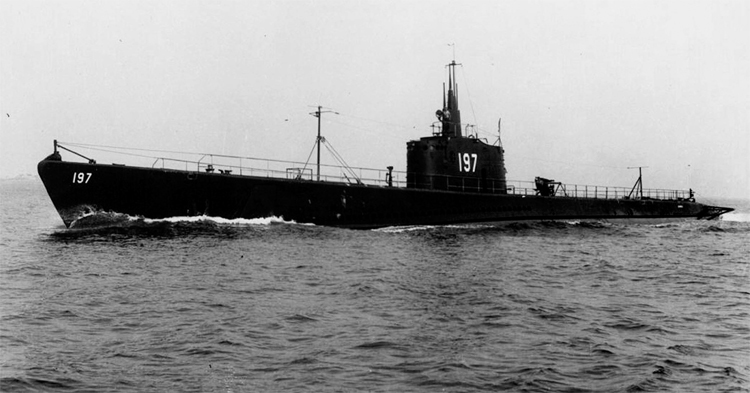
Shown here is Seawolf (SS-197), the fourth submarine in the Seadragon class of four boats. All were commissioned following the official beginning of the Second World War on 1 September 1939. Electric Boat built two and Portsmouth Naval Yard the other two. Almost identical to the preceding Sargo class, they featured a different propulsion system. (US Navy)
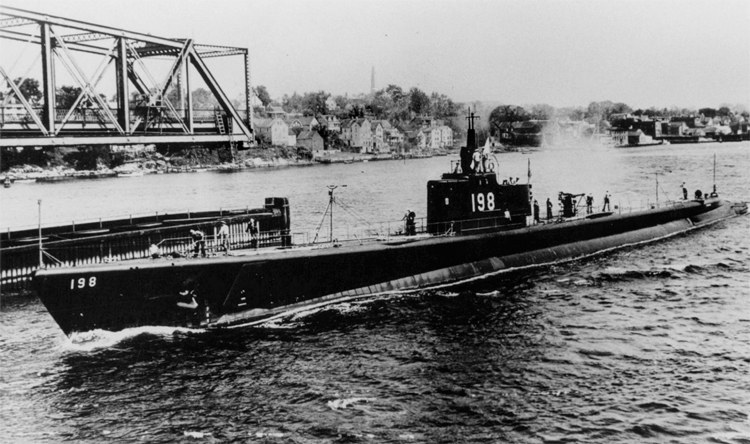
Pictured here is Tambor (SS-198), the first of twelve examples of the Tambor-class boats, all commissioned between June 1940 and May 1941. They proved to be the first fleet-type boats to have six bow torpedo tubes and provision for mounting 5in deck guns. Like the previous Seawolf class, the Tambor class had a test depth of 250ft. (US Navy)
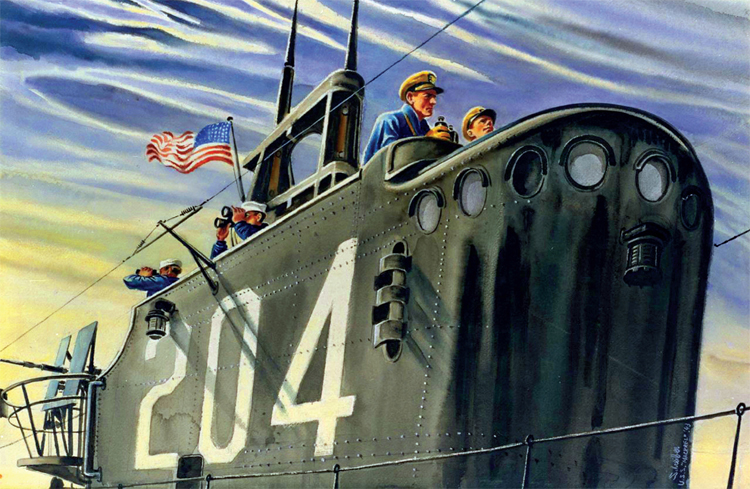
Here the artist has portrayed the fairwater and bridge of the Mackerel (SS-204), one of two small non-fleet-type submarines built during the early part of the Second World War. The other submarine in the Mackerel class bore the name Marlin (SS-205). Considered a design dead-end, neither would see combat. Instead they saw service only as training boats. (US Navy)
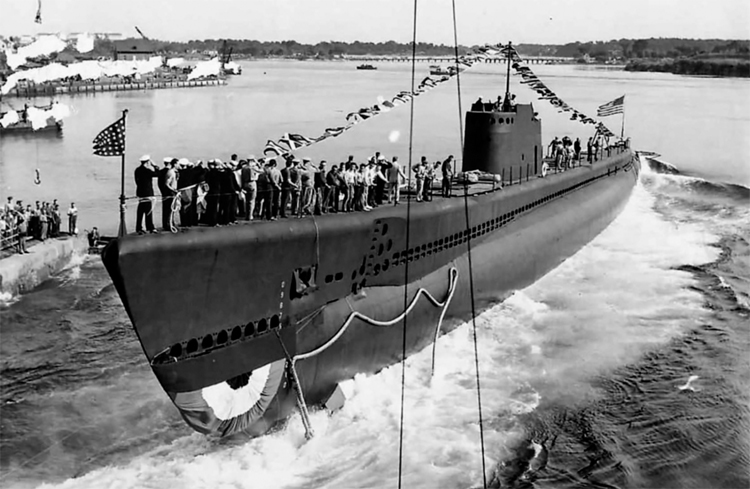
Shown under construction is the Grunion (SS-216), one of seventy-seven wartime-built Gato-class submarines. Its fairwater or superstructure has yet to be fitted. The US Navy reported the submarine lost with all hands around 30 July 1942, for unknown reasons. Found in October 2008, underwater research concluded that one of its own torpedoes might have circled back and destroyed the submarine. (US Navy)
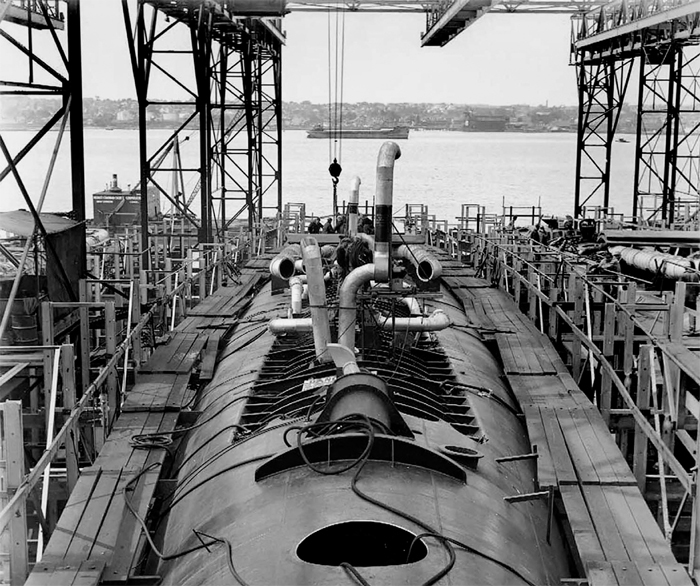
The launching of a Gato-class submarine named the Scorpion (SS-278) on 20 July 1942. Note the large pre-war-designed fairwater/bridge fitted to the submarine. The wartime censor has blocked out some of the background structures. Scorpion never returned from its fourth war patrol. The presumption is that it struck a Japanese underwater mine and sank. (US Navy)
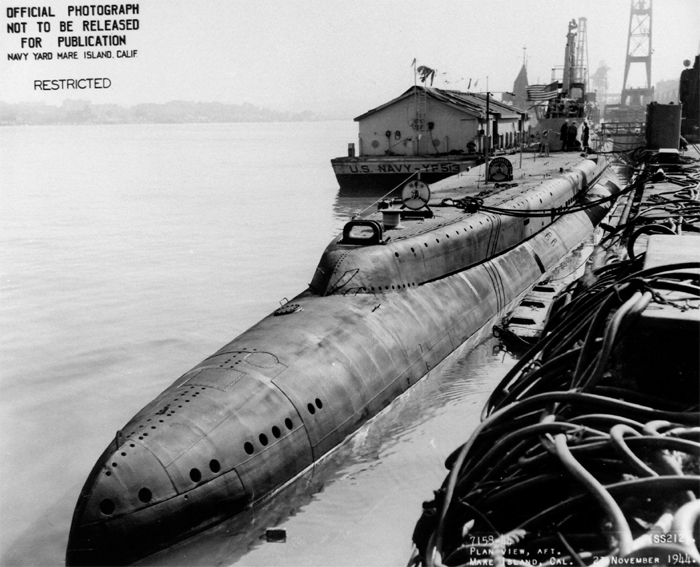
Pictured here is the stern of the Gato (SS-212). Descended from the Tambor-class submarines, the Gato-class boats were 4ft 6in longer and displaced an additional 51 tons. The submarine’s designers came to the conclusion that the pressure hull of the Gato class as built was capable of a test depth of 300ft rather than the 250ft test depth of the previous fleet-type submarines going back to the two boats of the Cachalot class. (US Navy)

The early-production Balao-class submarines resembled the Gato-class submarines coming out of modernized mid-war refits. Most of the differences were internal. An important design feature that appeared on the Balao class was the replacement of mild steel in the construction of the inner pressure hull with thicker high-tensile steel. This increased test depth to 400ft – 150ft deeper than the Japanese Navy thought possible – and was a tremendous advantage in evading depth-charge attacks. (Paul and Loren Hannah)
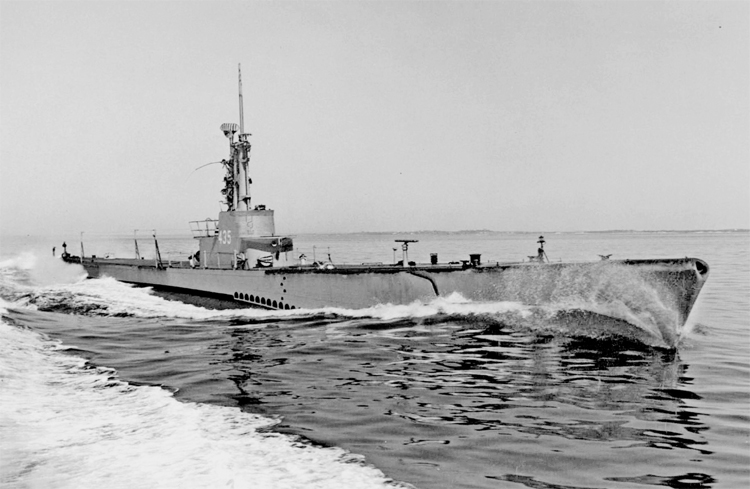
The last of the wartime-designed and built fleet boats were the Tench class. The example pictured here is the Corsair (SS-435). Laid down on 1 March 1945, the US Navy did not commission it until November 1946. Outwardly identical to the previous Balao-class submarines, the major differences in Tench-class boats were internal. Only eleven of the Tench-class submarines undertook war patrols, with none lost. (US Navy)
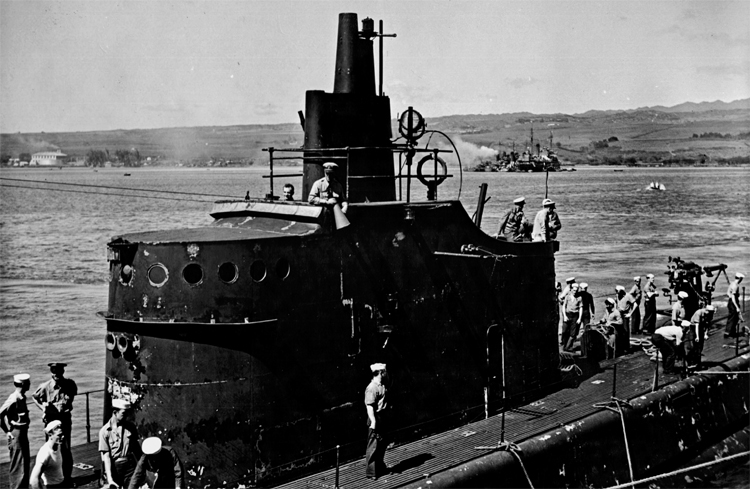
A close-up view of the large fairwater/bridge that appeared on the pre-war and early wartime-built fleet submarines. Its design had first appeared on the V-4 (SS-166), later assigned the name Argonaut. In this photograph, it appears on the Trout (SS-202) belonging to the Tambor class. Note the enclosed periscope housing. (US Navy)

In this picture we see the very elaborate enclosed bridge of a Sargo-class submarine that also appeared on follow-on fleet-type submarine classes through to the early-production Gato-class boats. Early wartime experience showed that they proved too noticeable to enemy observers due to their size. (US Navy)
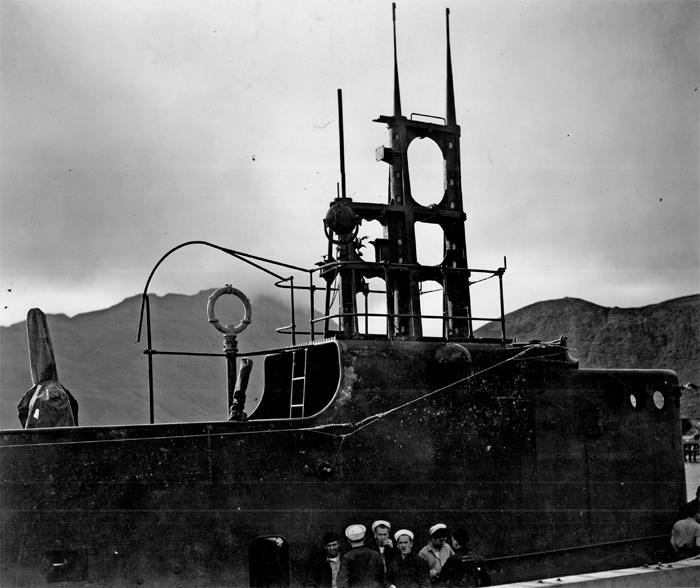
Another design issue that came to the forefront after some of the early war patrols in the Pacific related to the metal enclosure around the periscope shears of the fleet-type submarines. They had proved too visible to enemy observation and also trapped air, slowing a submarine’s descent during a crash dive and leading to their elimination as shown in this picture of the Gato (SS-212). (US Navy)
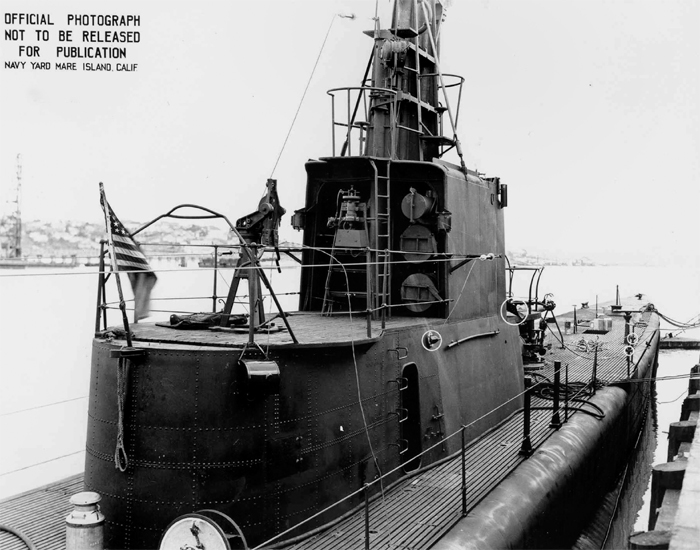
In this picture of an early-production Gato-class submarine, you can see that the metal enclosure around the aft platform deck (nicknamed the cigarette deck) of the fairwater/bridge has been cut away. There is now a mount fitted for a 20mm anti-aircraft gun. Note the extreme length of the rear portion of the fairwater, typical of early-war fleet boats. (US Navy)

In this picture, we see the Cero (SS-225), an early-production Gato-class submarine. Most of the original enclosed fairwater/bridge is gone. However, a portion of its roof remained and acted as a platform for the lookouts. A cigarette deck has now appeared on the forward portion of the fairwater/bridge for mounting an anti-aircraft gun, becoming a standard feature on the Gato/Balao/Tench submarines. (US Navy)

Another view of the cut-down fairwater/bridge of an early production Gato-class submarine, in this case the Bashaw (SS-241) built by General Electric. The US Navy commissioned the boat in October 1943. It performed six war patrols and accounted for three enemy ships and several smaller vessels. (US Navy)
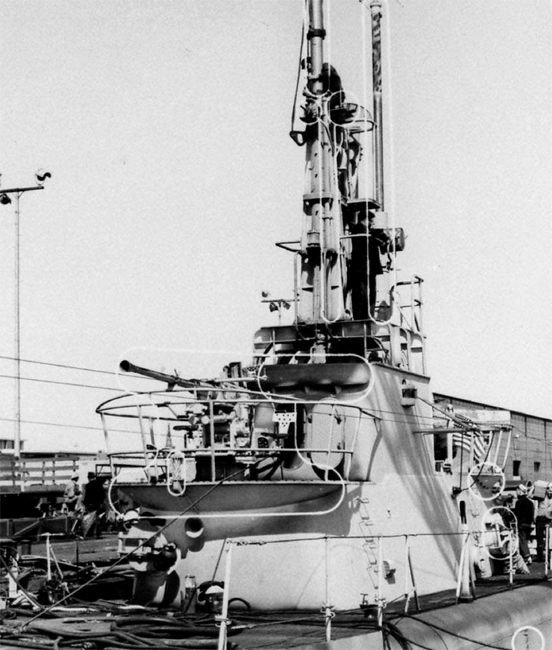
The Manitowoc Shipbuilding Company built the Redfin (SS-273) of the Gato class seen here from blueprints supplied by Electric Boat. Interesting visual detail is the faired-out bottom portion of the fairwater/bridge, a design feature not seen on the Gato-class submarines built in naval shipyards. (US Navy)
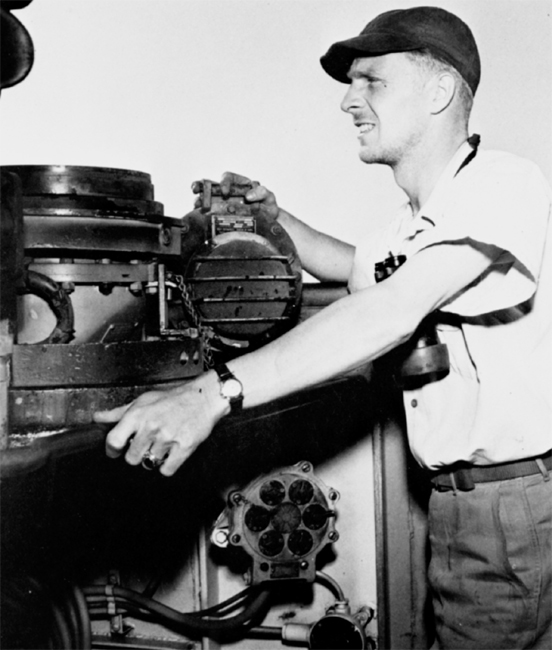
The submarine officer seen here on the bridge of a fleet-type submarine has his right hand on top of a loudspeaker, nicknamed the ‘squawk box’. With it, he can transmit verbal orders to the entire boat or just certain areas within. Directly below is a circular switchbox for an intercom system. Below that is the diving alarm switch. (US Navy)
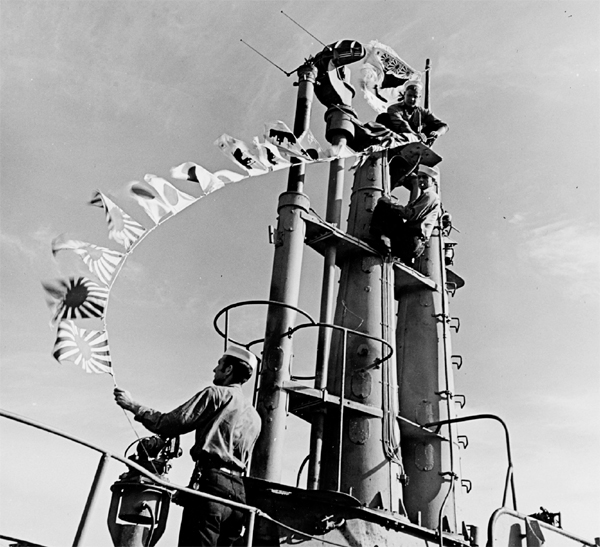
Sailors of the Balao-class submarine Batfish (SS-310) built at Portsmouth Naval Shipyard are seen here attaching victory pennants to their boat’s two periscope shears. Early-production Balao-class submarines constructed by US Navy yards like Portsmouth have a simplified periscope shear arrangement connected by horizontal support beams. Attached to the rear of the periscope shears are two connected masts for mounting radar antennas. (US Navy)
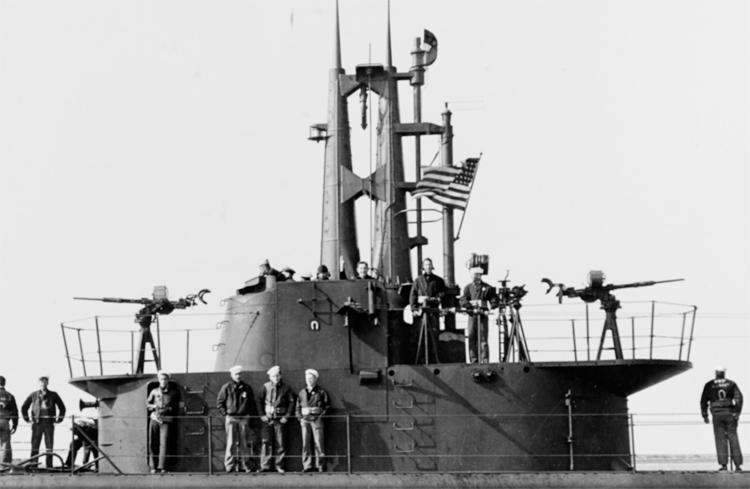
In this image we see the fairwater/bridge of the early-production Balao-class submarine Hardhead (SS-365) built by Manitowoc Shipbuilding Company to Electric Boat’s design. Note that the supporting framework connecting the two large periscope shears is of a different design to that of the early-production Balao-class submarines built by US Navy yards. (US Navy)
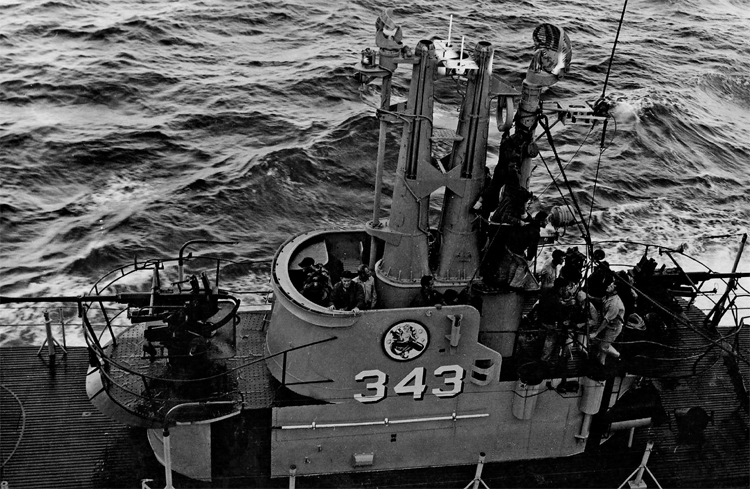
A view of the Clamagore (SS-343), an early-production Balao-class submarine built by Manitowoc Shipbuilding Company, shows the bridge arrangement of the boat’s fairwater. It features a 40mm anti-aircraft gun on either side of the fairwater/bridge, a late-war feature. Commissioned in June 1945, it arrived too late to see combat during the Second World War. (US Navy)

Appearing on late-production Balao-class submarines such as the Pampanito (SS-383) seen here and the follow-on Tench-class submarines was a revised arrangement of periscope shears and masts. Attached to the rear periscope shear is a mast mounting the paraboloid antenna of an SJ radar. Provided with its shear at the rear of the fairwater/bridge is the paraboloid antenna of an SV radar. (Paul and Loren Hannah)
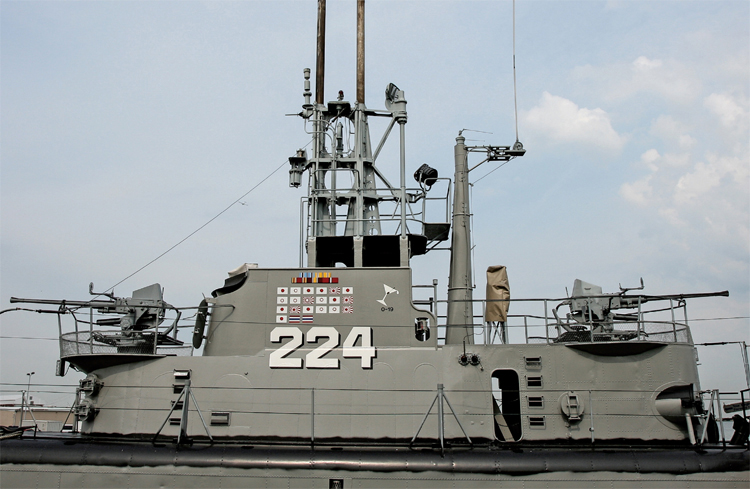
Due to the constant changes made to Gato- and Balao-class submarines during the Second World War, their silhouettes and deck gun arrangement varied greatly. Pictured here is the Gato-class submarine Cod (SS-224) in its late-war appearance, with two 40mm anti-aircraft guns and a separate shear at the rear of the fairwater/bridge for mounting a whip antenna. (Paul and Loren Hannah)
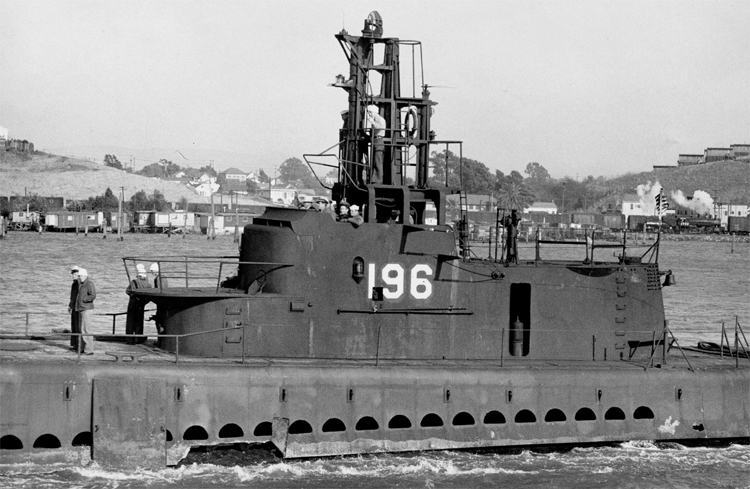
Not only were wartime Gato-class submarines’ fairwaters/bridges modified to reduce their silhouette, but many of the pre-war fleet boats also went through the same process. In this 1946 picture we see the Searaven (SS-196), a pre-war Sargo-class submarine, with a late-war Gato-class fairwater/bridge arrangement. (US Navy)
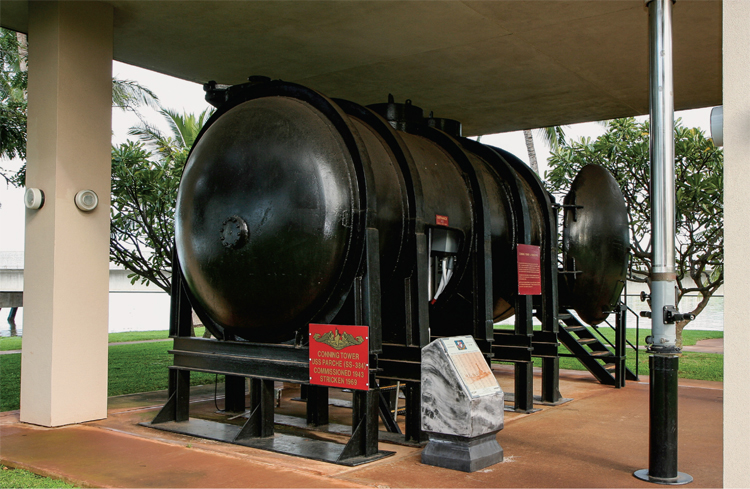
Inside the non-watertight fairwaters of all US Navy fleet-type submarines were watertight horizontal cylinders referred to as ‘conning towers’, as pictured here. Some 14ft long with a width of 8ft, they were the attack centres of the boats. The first horizontal conning tower appeared on the V-4 (SS-166) named the Argonaut. Previous US Navy submarine conning towers were vertical. (Paul and Loren Hannah)
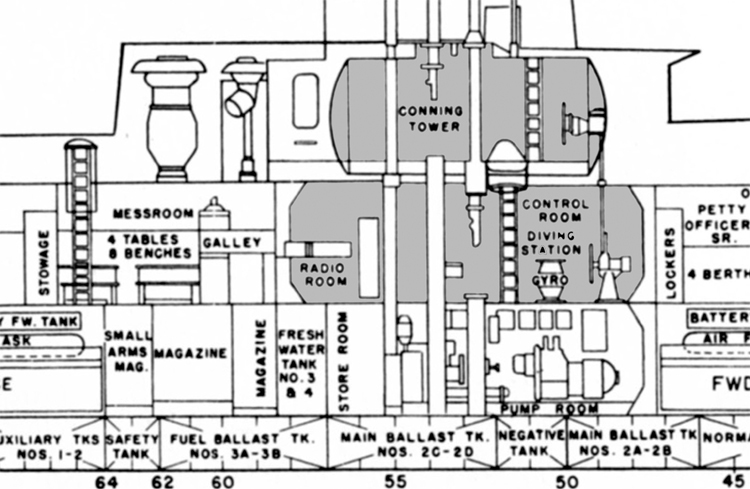
From a US Navy manual comes this line illustration of a Balao-class submarine which shows the location of the control room in the boat’s hull and the conning tower above it in the fairwater. The working arrangement between the men in the conning tower and control room during combat appears in the classic 1958 Hollywood submarine movie Run Silent, Run Deep starring Clark Gable and Burt Lancaster. (US Navy)
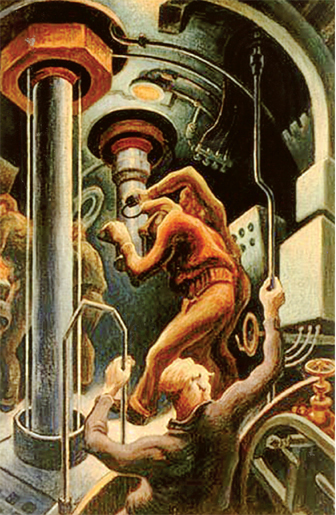
An artist’s representation of the conning tower within a fleet-type submarine during the Second World War. The submarine’s two periscopes could be raised and lowered from the bottom of the boat’s inner watertight pressure hull via cables for viewing from the conning tower or the control room which was located directly below.
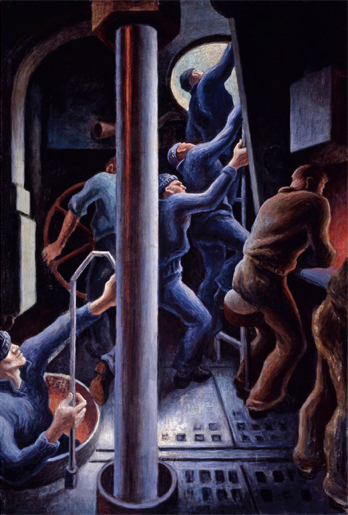
Despite the advent of a variety of electronic sensors such as radar and sonar on wartime US Navy fleet-type submarines, human lookouts remained an important asset on such vessels throughout the war in the Pacific. In this artist’s portrayal we see the lookouts scrambling through a submarine’s conning station to reach their stations on the fairwater/bridge. (US Navy)
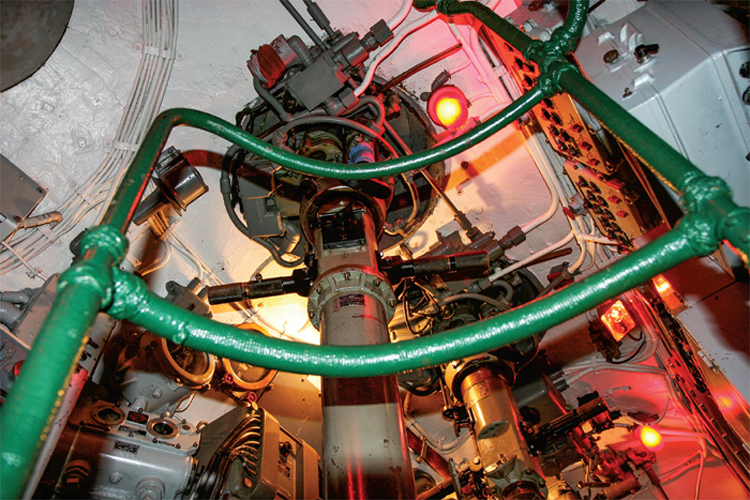
Inside the Cod (SS-224), a Gato-class submarine, we see the ladder leading up from the control room to the conning tower. Both of the submarine’s periscopes are visible. Other devices located in the conning tower would be a radio direction-finder, a gyro repeater and pressure gauges. (Paul and Loren Hannah)
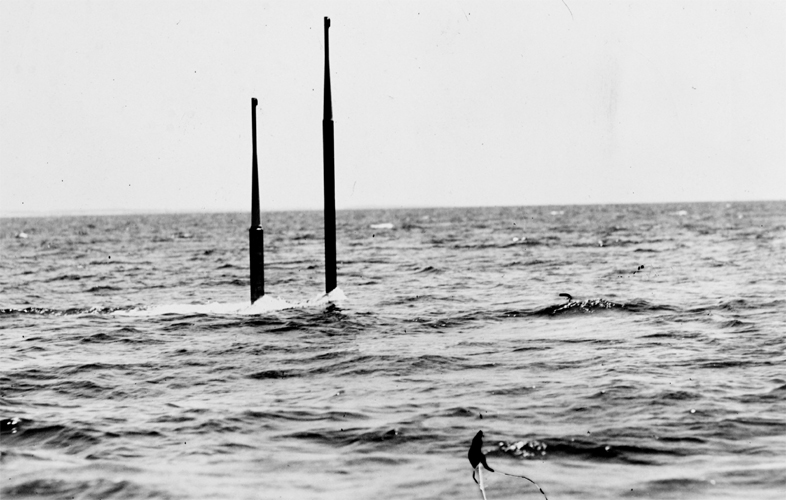
Pictured here are the two periscopes of submarine V-5 (SS-167) named the Narwhal. The forward periscope is always referred to as No. 1 and the periscope behind it as No. 2. On early-production Gato-class submarines, their No. 1 periscope was labelled the ‘attack periscope’ or ‘needle periscope’ as it had a minimum diameter head to minimize its ‘feather’ (how much the water’s surface was disturbed), as well as the visibility of the periscope itself. (US Navy)
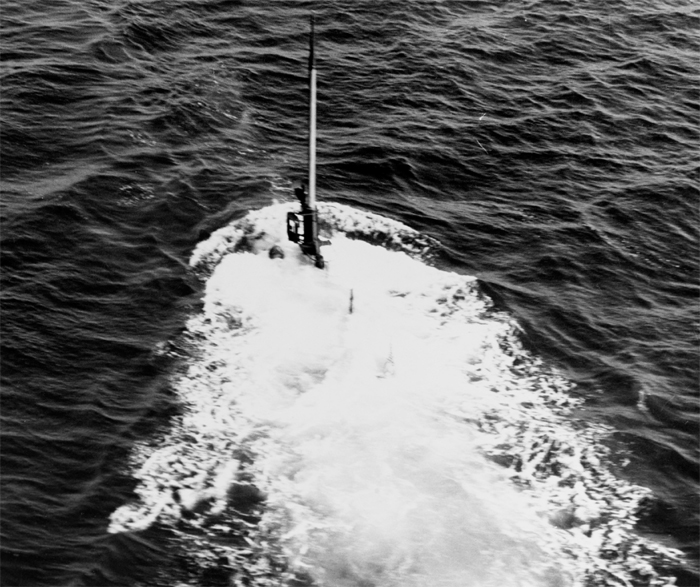
The problem created by the feather and wake of a submarine’s periscope and upper portion of its fairwater during daylight is evident in this photograph of the Pike (SS-173), a member of the Porpoise class of submarines. US Navy manuals recommended that submarine commanders expose their periscopes only when running at the slowest possible speed to reduce the wake. (US Navy)
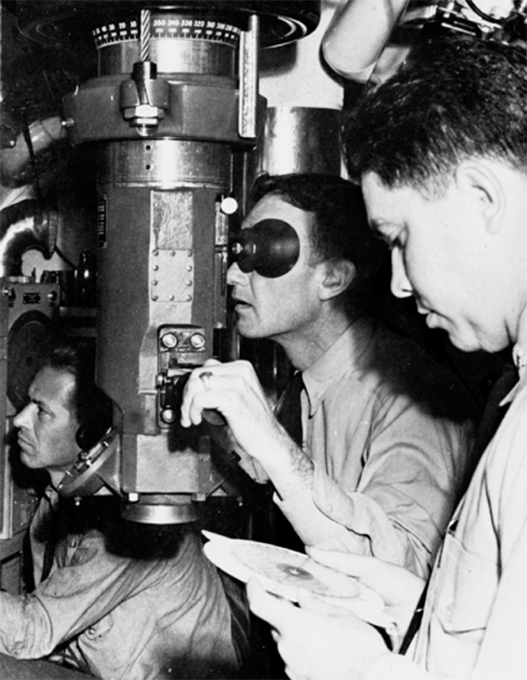
The submarine commanding officer is looking into one of his two periscopes. At the top of the periscope is a scale employed to determine the target’s bearing (direction). Visible at the bottom of the periscope on both sides are stadimeter dials. The officer to the right, helping his commanding officer develop a firing solution, is holding a slide rule to calculate the ‘AOB’ (angle on the bow, or target angle). (US Navy)
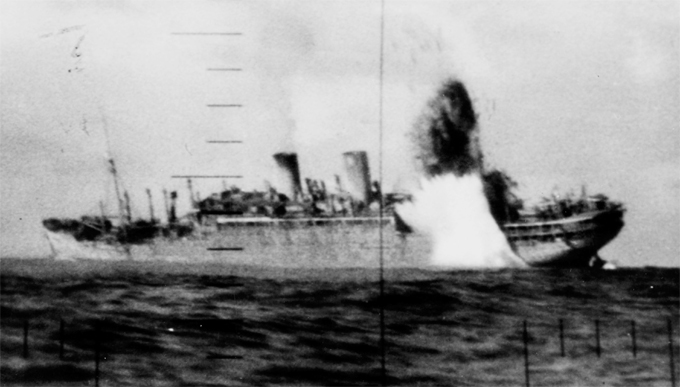
In this image we see the moment of impact when a torpedo from Puffer (SS-268), a Gato-class submarine, strikes a Japanese ship. Besides the small diameter head attack periscope, the Gato class originally had a large diameter search periscope with a wide-angle view. Like the attack periscope, it could be elevated to observe the sky around the submarine. (US Navy)

The importance of selecting the right men on submarines as lookouts appears in this passage from a US Navy manual: ‘Every effort shall be made to pick the best men possible for this duty, and their training shall be carefully supervised . . . All bridge personnel shall be tested for night vision and none showing unsatisfactory night vision shall be so employed.’ (US Navy)

In this artwork we see a US Navy submarine returning to confirm the sinking of the enemy ship it had engaged during a war patrol. US Navy submarines conducted 1,474 war patrols in the Pacific. Patrols varied from 35 days’ to 60 days’ duration with an average of 50 days. Firing all torpedoes during the initial stages of a patrol or suffering serious damage from enemy ASW attacks could prematurely end a patrol. (US Navy)
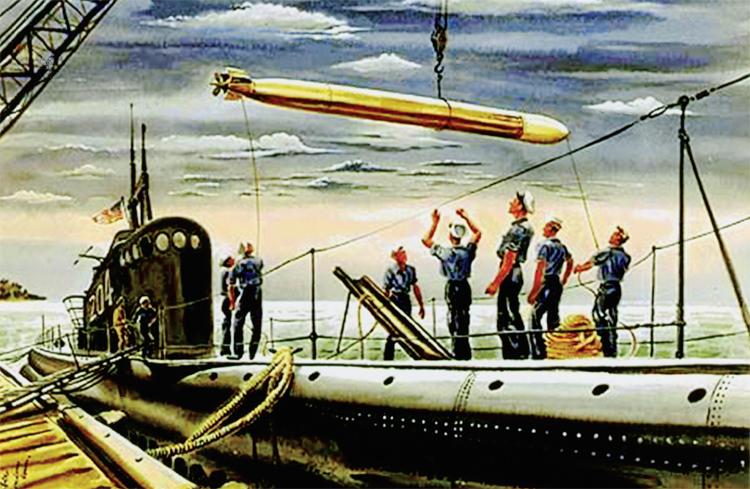
This painting shows a torpedo coming on board an early-production Gato-class submarine. US Navy submarines entered into combat following Pearl Harbor with Mk. 10 torpedoes that could run at 36 knots to 3,500 yards and the Mk. 14 torpedo that could run at either 31 knots or 46 knots up to 9,000 yards. (US Navy)
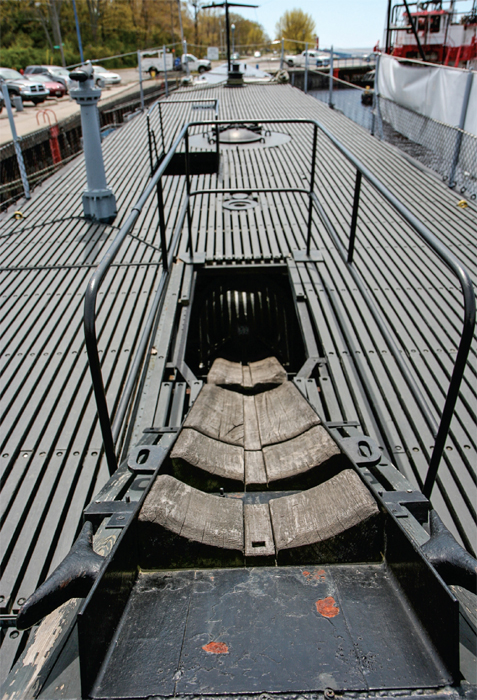
There were hatches on top of both the forward and aft torpedo compartments for loading torpedoes. To assist in stowing the 16ft-long, 2,215lb Mk. 10 and the 20ft-long 3,209lb Mk. 14 torpedoes the crew erected a metal slide with wooden slats as pictured on the Gato-class submarine Silverside (SS-263). (Paul and Loren Hannah)
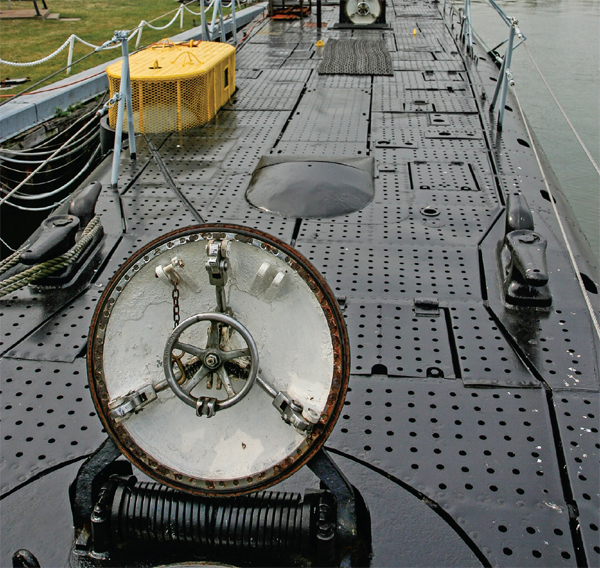
Visible in the very foreground of this picture is the after escape and rescue hatch for the aft torpedo compartment on the Cod (SS-224). In the background is the closed aft torpedo loading hatch. To its left, the yellow-painted object is the submarine’s aft emergency locator buoy. The bow emergency locator buoy is flush with the bow superstructure deck and hence not visible. (Paul and Loren Hannah)
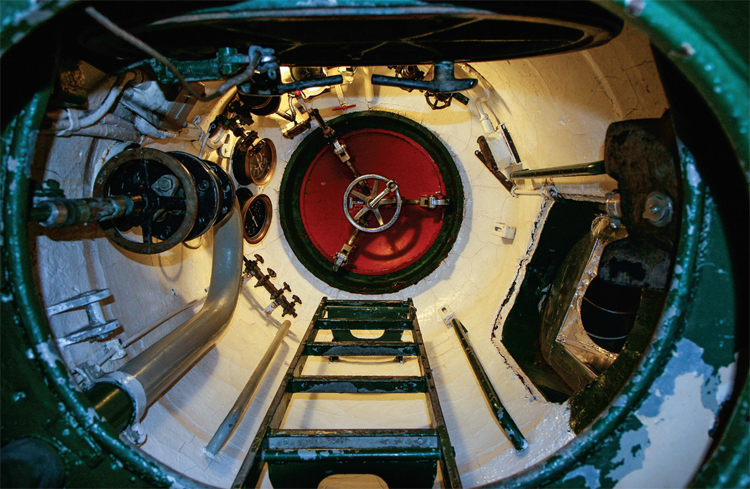
On the Gato-class submarine Cobia (SS-245), looking up from the forward torpedo compartment we see the long ladder that leads to the closed forward escape and rescue hatch. The men that served on submarines were all volunteers. Reflecting the dangers of such service, enlisted submarine personnel received $100.00 a month rather than the $50.00 paid to those serving ashore or on surface ships. (Paul and Loren Hannah)

Visible is the forward torpedo compartment, or room, of the Cobia (SS-245), a Gato-class submarine. Clearly visible are four of the six bow torpedo breech doors. The two remaining torpedo breech doors are below the platform deck, so are a bit harder to see. The crew had to remove some of the platform deck panels to load torpedoes in the bottom tubes. (Paul and Loren Hannah)

On display here is a submarine’s 21in torpedo tube barrel. The tube was built from three bronze castings, referred to as the breech, middle and muzzle sections. The sections were cold-riveted together to form a continuous cylinder, with the joints sealed with solder. On the bottom of the torpedo barrel were four rollers to ease a torpedo into the barrel. (Paul and Loren Hannah)
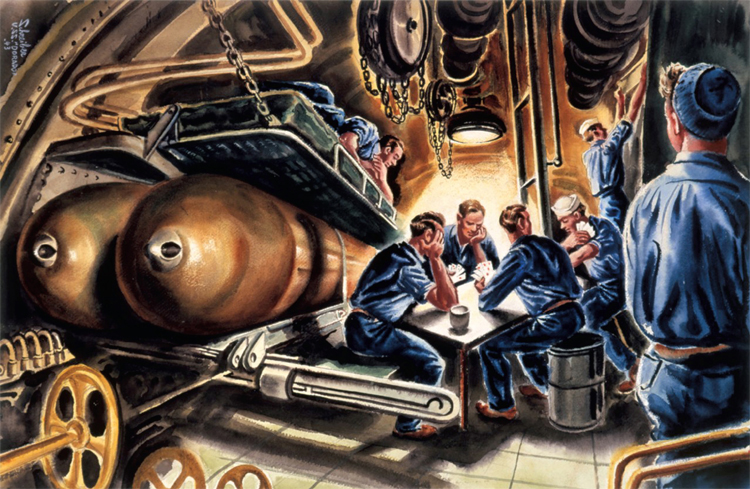
In this painting we see a group of torpedomen passing their free time playing cards. The forward and aft torpedo rooms on Gato-, Balao- and Tench-class submarines had berthing space for approximately fifteen men each. However, some of these bunks were not usable until a certain number of torpedoes had been fired. (US Navy)
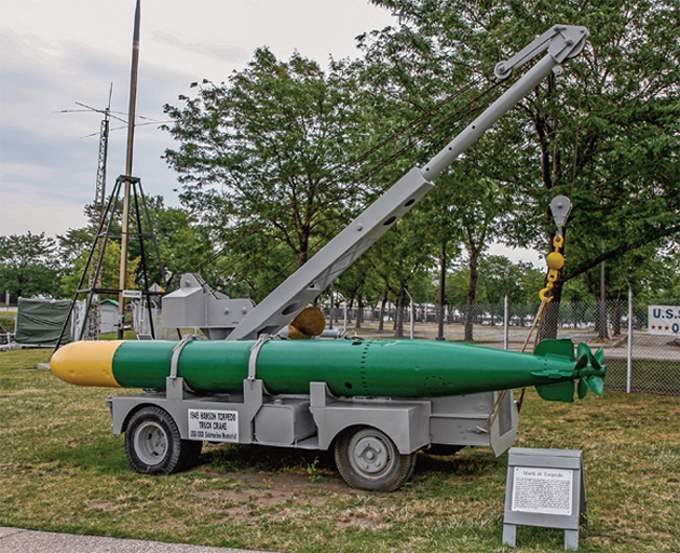
The steam-turbine-powered Mk. 14 torpedo pictured here had a warhead of approximately 500lb of TNT, later replaced by 668lb of Torpex. After exiting a torpedo tube, the arming mechanism required 450 yards’ travel before arming. Serious design flaws with the torpedo’s depth-keeping and Mk. 6 exploder greatly hindered its performance until late 1943. (Paul and Loren Hannah)
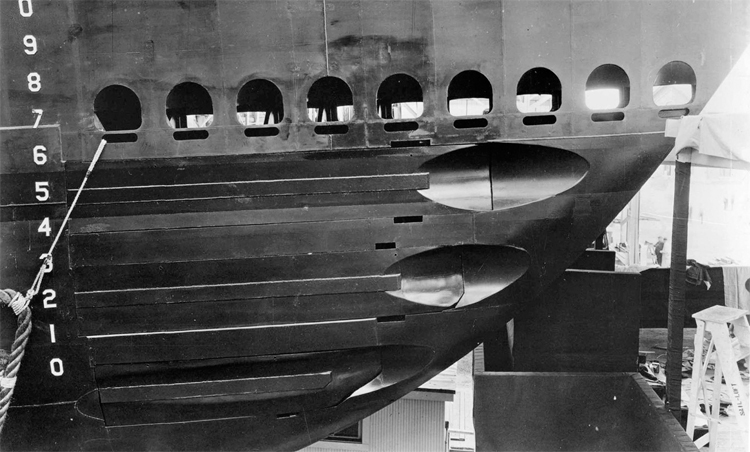
In the upper picture, we can see the closed bow torpedo shutters of the Tambor-class submarine Grayling (SS-209).
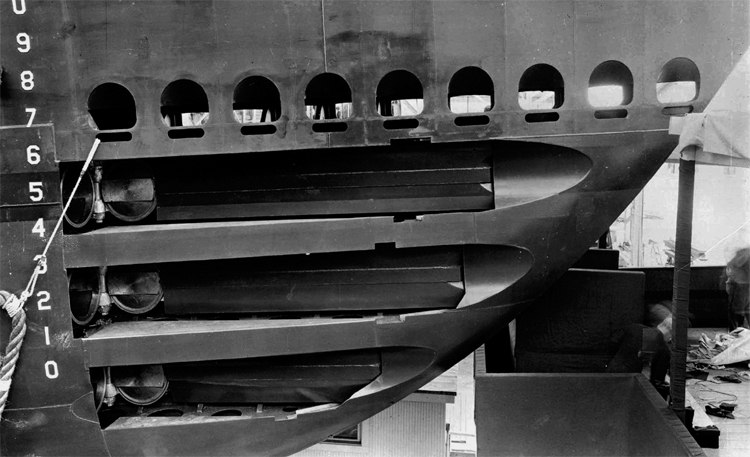
The image below shows the torpedo shutters doors in their open positions, having folded inward, thereby exposing the muzzle doors of the torpedo tubes before firing. The torpedo tubes’ inner breech doors are connected to the muzzle doors by an interlocking mechanism that makes it impossible to have both open at the same time. (US Navy)

An artist has painted a view of the aft torpedo room on a Gato-class submarine during a training exercise, as indicated by the casual posture of the majority of personnel present. Note the overhead chains and pulleys that were used by the sailors to move the heavy torpedoes off storage racks into the torpedo tubes. (US Navy)
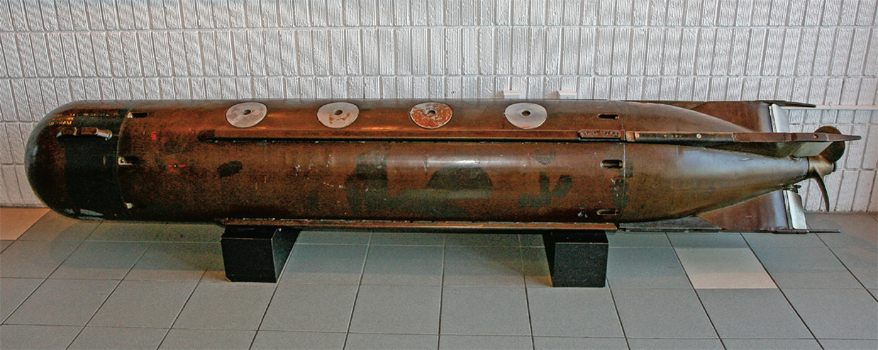
To aid its submarines when attacking enemy surface ASW ships, the US Navy developed a small homing torpedo designated the Mk. 18. Equipped with a hydrophone (passive sonar), it could be launched from as deep as 150ft or more and find its way to the loudest noise in the immediate area, be it an enemy surface ship or submarine. It arrived very late in the war and hence saw limited use. (Paul and Loren Hannah)
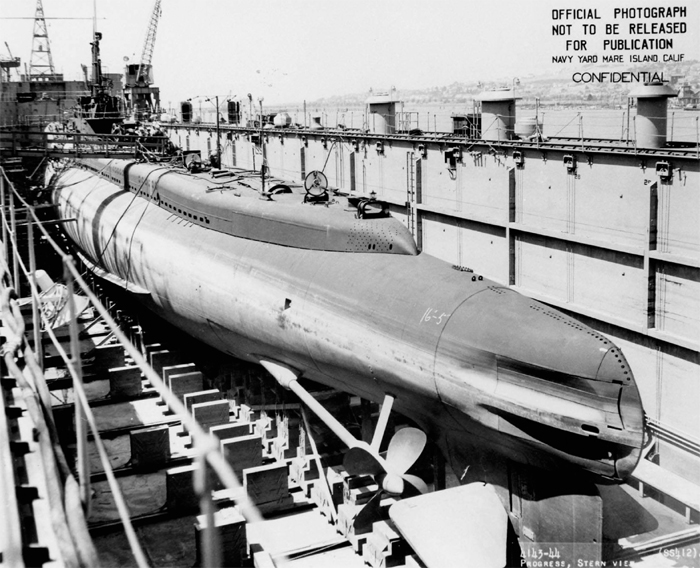
In this image of the Balao-class submarine Trepang (SS-412) its four stern torpedo tubes are visible. During the war in the Pacific, US Navy submarines sank 1,113 merchant ships with another 65 probables. They also sent 201 Japanese naval ships to the bottom with another 13 probables. Included in that number were 4 aircraft carriers, a battleship and 23 submarines. (US Navy)
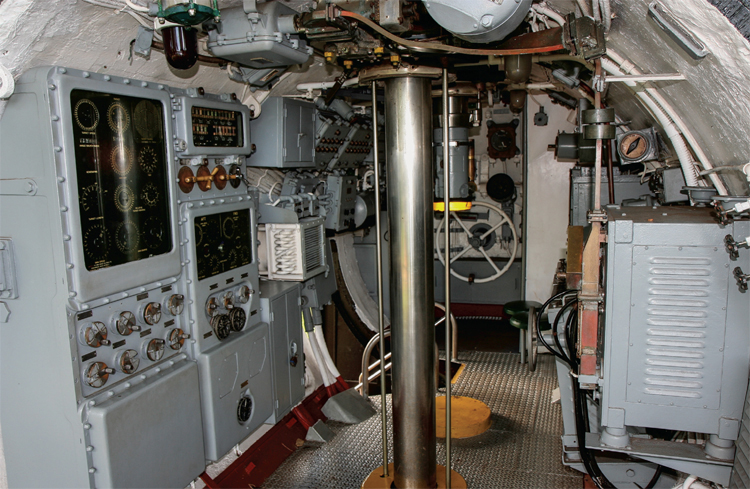
Greatly increasing the possibility of a US Navy submarine torpedoing its target during the Second World War was the Torpedo Data Computer (TDC), an analogue (mechanical) computer. The TDC automatically tracked the target and computed a firing solution. An example is seen here on the left-hand side of the conning room of the Balao-class Parche (SS-384). (Paul and Loren Hannah)
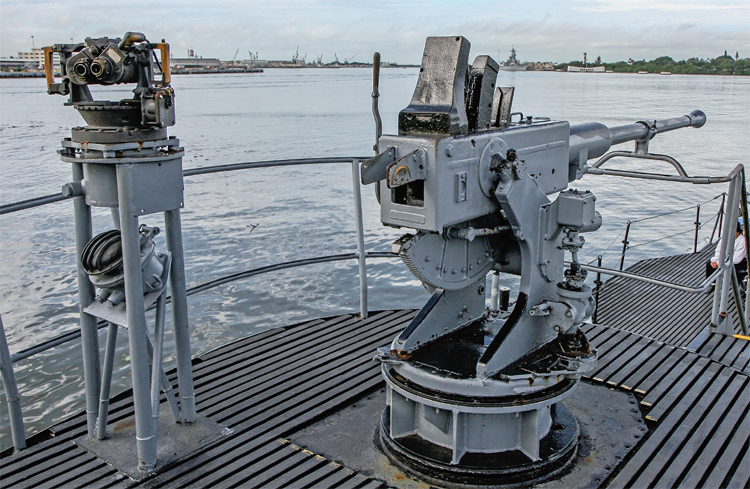
The inputs necessary for the TDC to compute a firing solution came from a variety of onboard sources. When running on the surface, there was the Target Bearing Transmitter (TBT) seen here on the cigarette deck of a Gato-class submarine to the left of the 40mm anti-aircraft gun. (Paul and Loren Hannah)
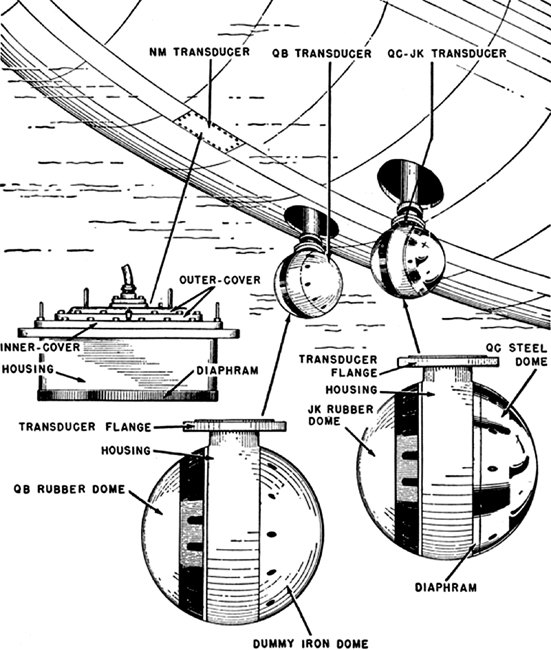
Visible in this line illustration from a US Navy manual is the retractable spherical hydrophones (referred to as projectors) of a WCA sonar unit intended to detect supersonic noises under the submarine’s bow. When a target is detected, the echo-ranging sonar is trained to the target bearing and a single short ‘ping’ is emitted to determine range. (US Navy)
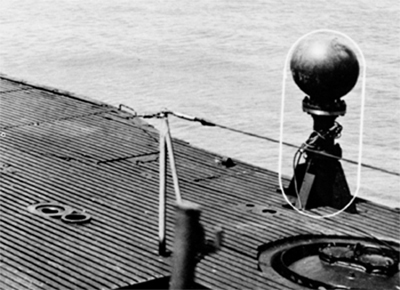
The retractable pairs of spherical hydrophones of a WCA sonar unit originally mounted under submarines’ bows proved damage-prone and therefore were eventually replaced by a single non-retractable projector. The WCA sonar could operate in both active and passive modes. (US Navy)
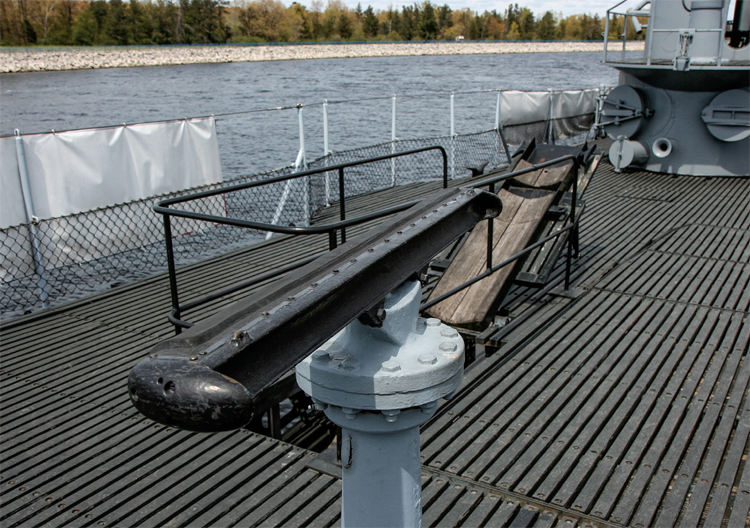
On the forward superstructure deck of Gato-class submarine Silversides (SS-236) is seen the JP hydrophone (sonar) head intended to detect sonic noises. It began appearing on US Navy fleet-type submarines in 1943. By the middle of 1945, a much more capable passive sonar system designated the JT began appearing on US Navy submarines. (Paul and Loren Hannah)
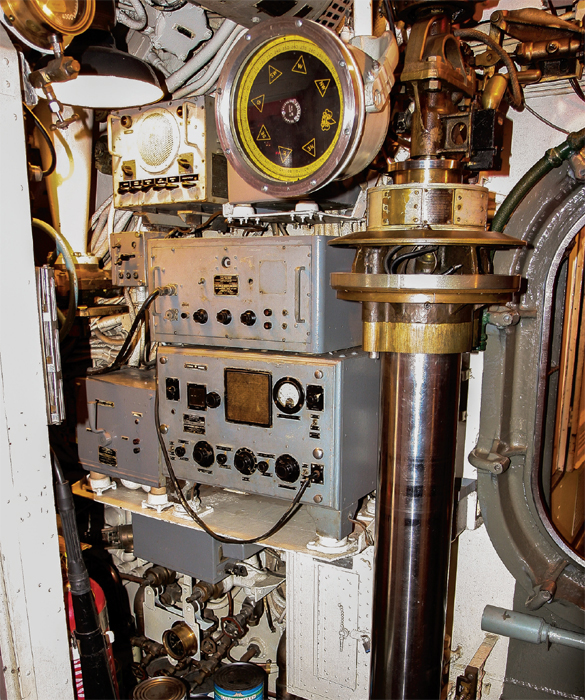
Inside the forward torpedo room of a US Navy submarine we see the receiver-amplifier for either an exterior WCA sonar projector or the exterior T-shaped antenna of the JP sonar unit. Both sonar heads were mounted on shafts that could be turned manually or power-operated from a submarine’s conning tower. (Paul and Loren Hannah)
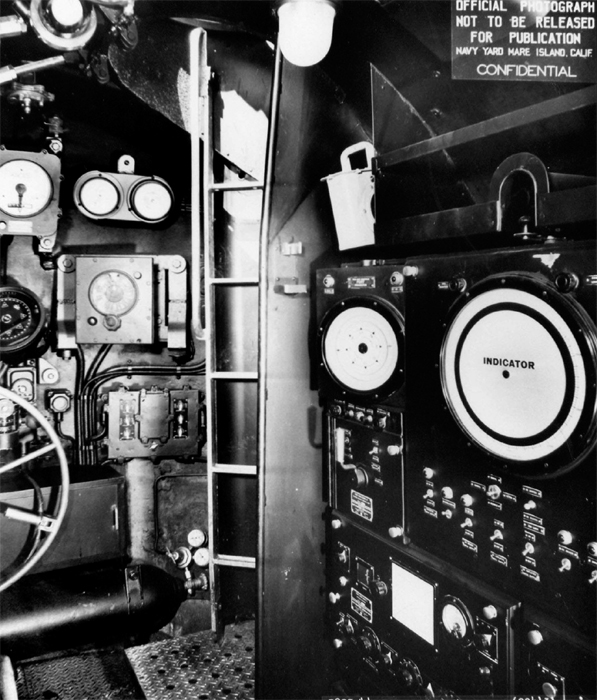
In this picture we are looking into a Balao-class submarine conning tower. On the far right is the WCA stack that houses all a submarine’s supersonic sonar detection. Sonic sounds travel further in water than supersonic sounds so that sonic-range sonar can detect targets at greater distances. Supersonic sonar, on the other hand, can detect the high-frequency sounds emitted by enemy ASW vessels’ own active (search-mode) sonar. (US Navy)
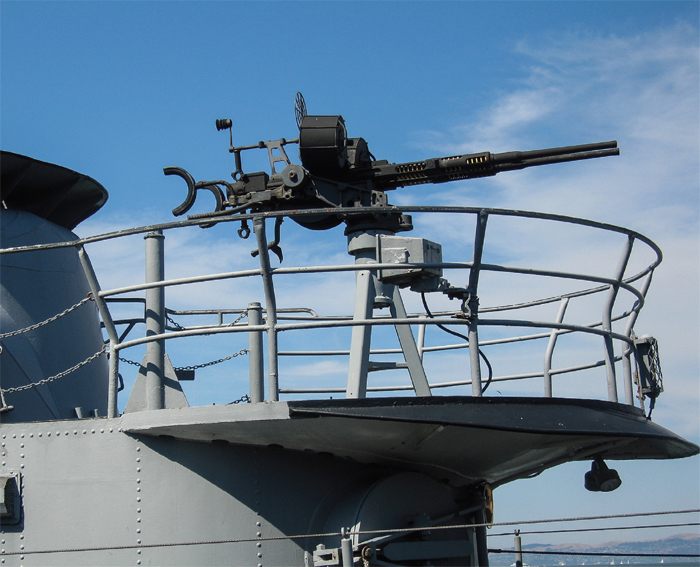
The standard prewar armament for US Navy fleet-type submarines was .30 calibre and .50 calibre machine guns. Too short-ranged to be effective, they were replaced by single-barrel 20mm anti-aircraft guns mounted on the submarines’ fairwater or superstructure decks. Late in the Pacific War, some US Navy submarines had twin-mount 20mm anti-aircraft guns installed, as pictured here. (Paul and Loren Hannah)
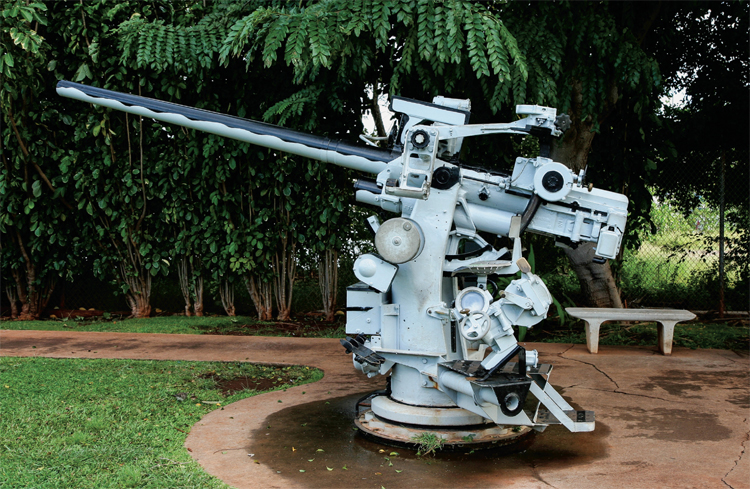
Most pre-war US Navy submarines following the S-class had a single 3in deck gun as seen in this picture. Besides referencing bore diameter, the US Navy also described them by barrel length in calibres (multiples of the bore size) instead of inches. Hence the 3in guns on submarines were designated 3in/.50 calibre guns. (US Navy)
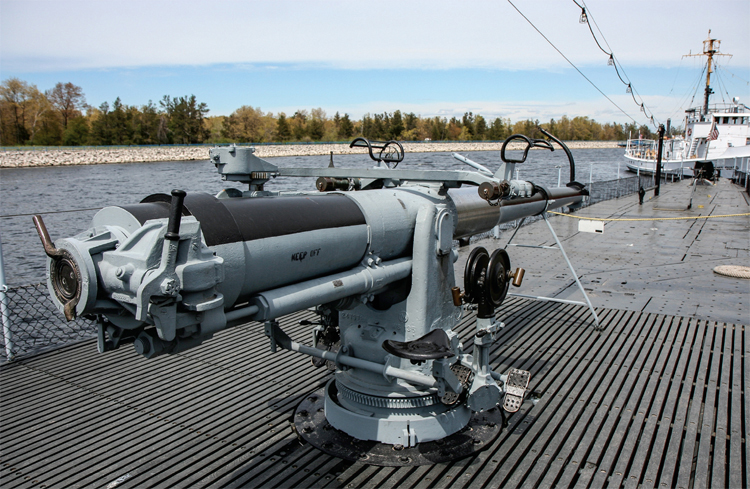
The single 3in/.50 calibre deck gun’s ineffectiveness on early-production Gato-class submarines led to their replacement by the 4in/.50 calibre deck guns removed from inactivated S-class submarines. The example pictured here is on the Gato-class submarine Cobia (SS-245) which conducted six war patrols and accounted for a total of thirteen Japanese ships. (Paul and Loren Hannah)
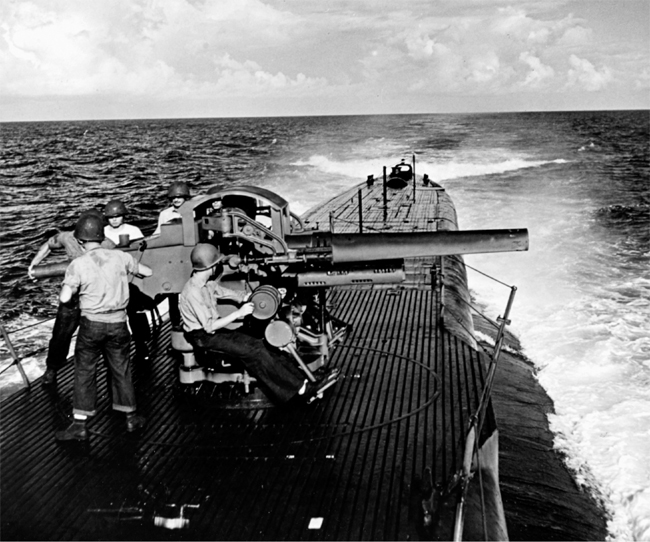
A wartime image of a 5in/.25 calibre deck gun crew in action. This type of gun first appeared on the Balao-class submarine Spadefish (SS-411) commissioned in March 1944. It soon became the standard deck gun for the Gato/Balao/Tench-class submarines, replacing the older-generation 3in and 4in deck guns during refits and new construction. Seven late-war-production Balao-class submarines had two of the 5in deck guns fitted. (US Navy)
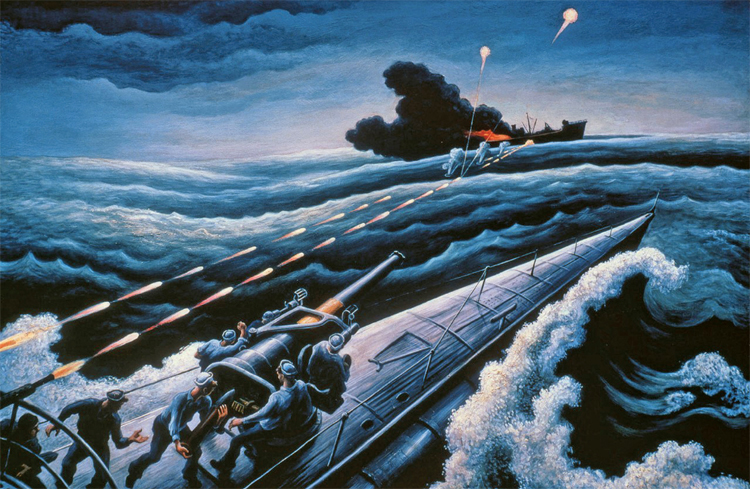
The artist has painted the early-production Gato-class submarine Dorado (SS-248) firing on a derelict cargo ship for target practice during its shakedown cruise in the summer of 1943. Following its commissioning later that year, Dorado sailed for the Pacific from the American East Coast via the Panama Canal. However, it never arrived at the canal and it’s considered possible that Dorado was sunk by mines planted by German U-boat U-214 near the Atlantic entrance to the canal. (US Navy)
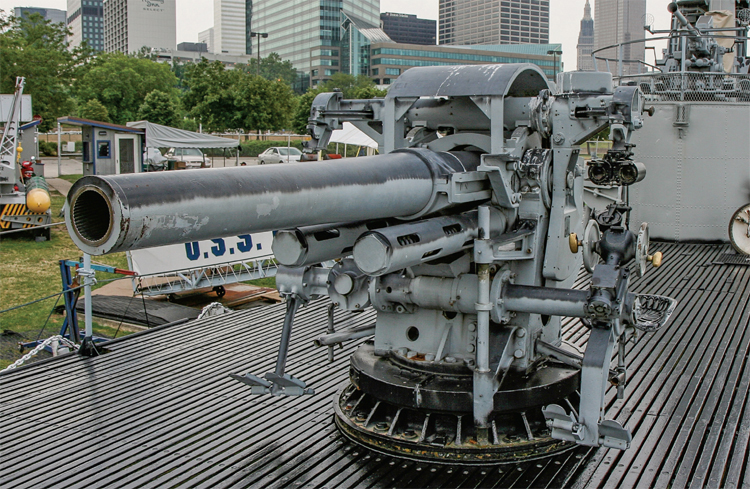
Seen here on the Gato-class submarine Cod (SS-204) is a 5in/.25 calibre deck gun. This particular weapon sank five Japanese ships and twenty-six smaller vessels during the Second World War. To prevent corrosion, the barrel of the gun is chrome-plated, and such weapons are referred to as ‘wet mounts’. It fired a 54lb high-explosive round. (Paul and Loren Hannah)
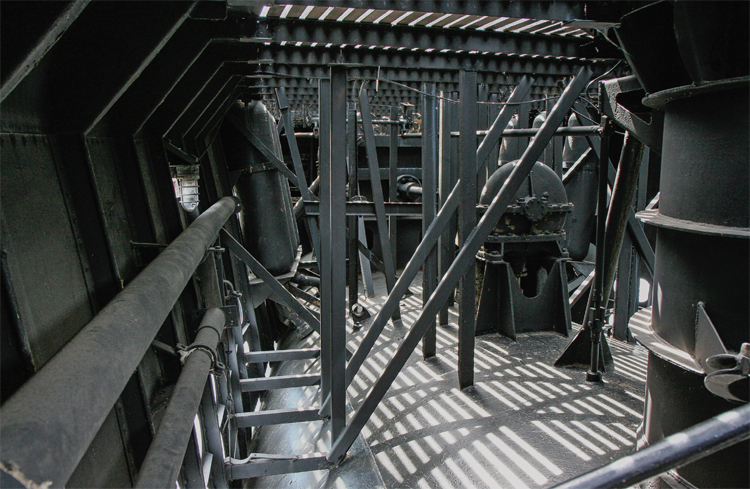
In this image we see the support arrangement for the free-flooding superstructure located above the outer bow hull of the Gato-class submarine Silversides (SS-236). The outer hull of the submarine tapers downward, as is evident in the photograph. The actual pointed nose of the submarine is part of the superstructure, and the upper portion is referred to as the bow buoyancy tank. (Paul and Loren Hannah)

Pictured here is an artist’s interpretation of the port-side bow and stern diving stations located within the control room of a fleet-type submarine. Directly above the submarine’s control room is the conning tower that could be accessed by the ladder seen on the left of the painting. The two diving station operators doubled as lookouts when the submarine surfaced. (US Navy)
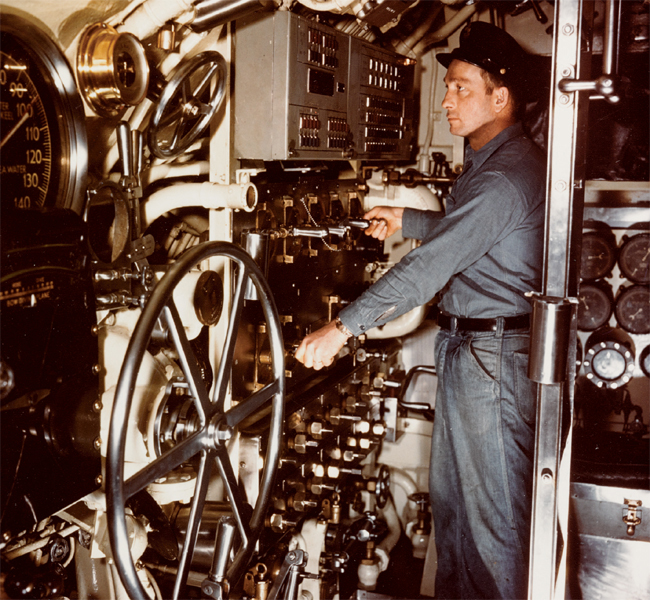
Located on the right-hand side of the bow and stern diving stations of a fleet-type submarine were the hull opening indicator and the various levers for the main hydraulic control system seen here monitored by the submariner pictured. Before submerging, all the lights on the hull opening indicator panel had to be green, showing that all submarine hatches and air-intake valves had closed properly. (US Navy)
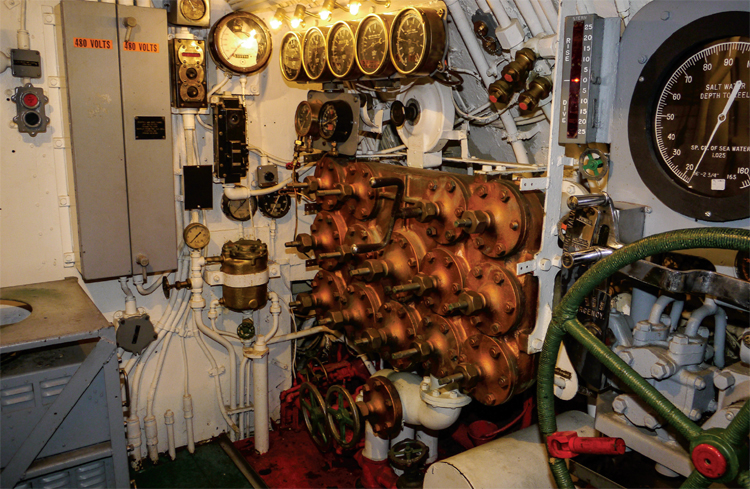
Visible in this image are a submarine’s trim manifolds as well as trim tank gauges and trim pump controls located in the control room. A trim system is employed chiefly to maintain the boat’s balance and stability. This was an important feature as submarines tend to be top-heavy, despite the fact that all their heavy machinery and storage batteries were located as low as possible within their pressure hulls. (Paul and Loren Hannah)
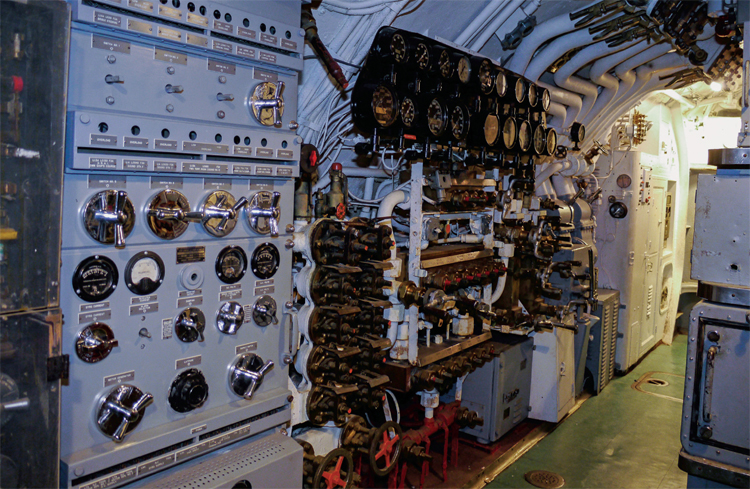
On the port side of the control room (opposite the bow and stern diving stations) can be seen on the left-hand side of the picture the submarine gyrocompass control board. To its right are the controls for the various air manifolds. Almost every operation in the submerging and surfacing process of a submarine is dependent on air supplied by one or more of the boat’s air systems. (Paul and Loren Hannah)

The open hatch on the right side of the picture would lead to the ship’s officers’ living quarters. The round object in the left foreground is the master gyrocompass. In the centre of the picture is the boat’s steering wheel, which turns the rudder and is operated by a helmsman/steersman. There is also a second steering wheel in the submarine’s conning tower. (Paul and Loren Hannah)
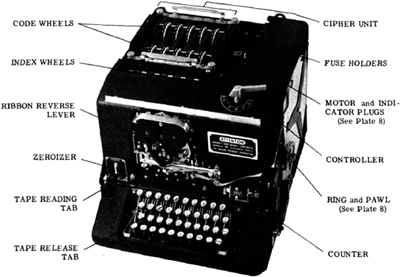
The American counterpart of the well-known German military cipher system ‘Enigma’ was the electrically-powered ECM (Electric Cipher Machine) Mk. 2 seen here from a US Navy manual. It was found on the US Navy’s surface warships and submarines during the Second World War. The same device when employed by the US Army had the designation SIGABA. (US Navy)
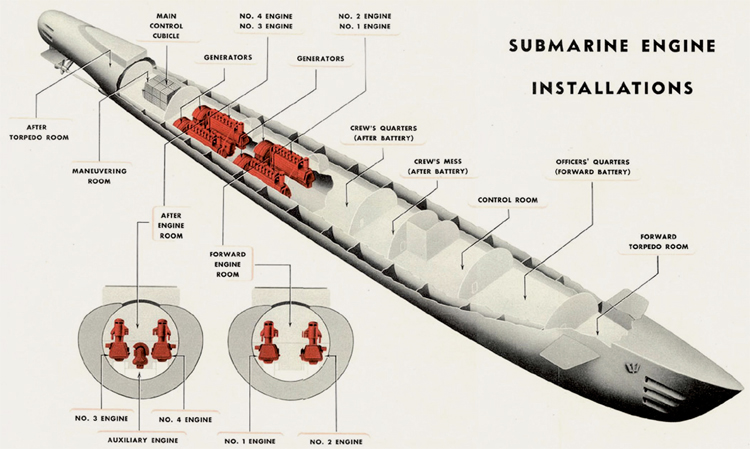
The Gato/Balao/Tench-class submarines received power from either four Fairbanks-Morse (FM) diesel engines or four General Motors diesel engines. The engines were divided between two separate engine compartments as seen in this illustration from a US Navy manual. The engines were air-started and cooled by a combination of fresh and seawater systems. (US Navy)
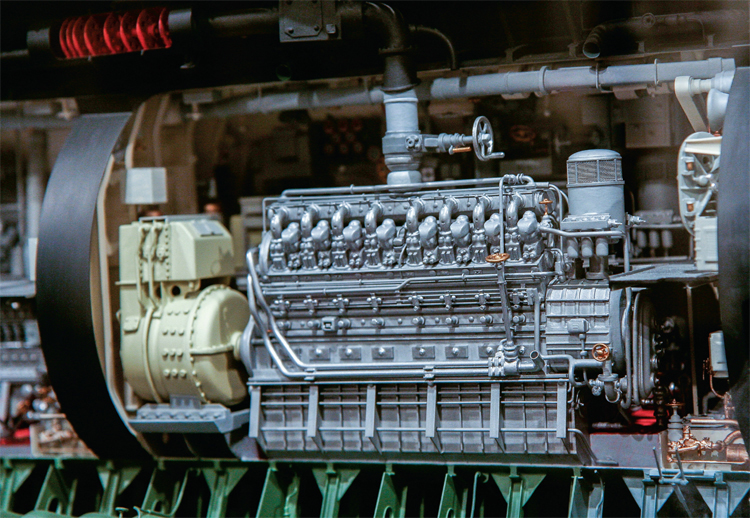
In this picture of a model of a Balao-class submarine, it is possible to gain a sense of the massive size of just one of the four two-cycle General Motors main diesel engines that powered the boat. Behind each diesel engine is one of the submarine’s four main electric generators that each produced 1,110kw which in turn powered four high-speed electric motors that turned the propeller shafts through reduction gears. (Paul and Loren Hannah)
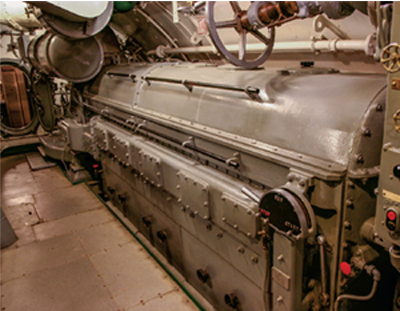
Some Gato/Balao/Tench-class submarines received power from Fairbanks-Morse (FM) diesel engines with an example seen here. When running on the surface, the noise within submarine engine rooms proved deafening, requiring the crews to communicate by hand signals. When the diesel engines were shut down for submerged running, the engine rooms would instantly rise to over 100 degrees due to heat buildup within the engines while running for hours. (Paul and Loren Hannah)

At the rear of the manoeuvring room located behind the aft engine room is the main propulsion control cubicle seen here. The electricians manning Batfish (SS-310), a Balao-class submarine, employ operating levers to perform many functions. These include starting, stopping, reversing and regulating the speed of the four main electric propulsion motors for both surface and submerged running. (US Navy)

With the typical wartime Gato- and Balao-class submarines having a crew complement of eighty men and operating around the clock when on patrol, the boat’s galley was always a busy place. To offset the submarines’ not-so-pleasant living conditions, the US Navy tried to make sure the food on board would be the best possible. (Paul and Loren Hannah)
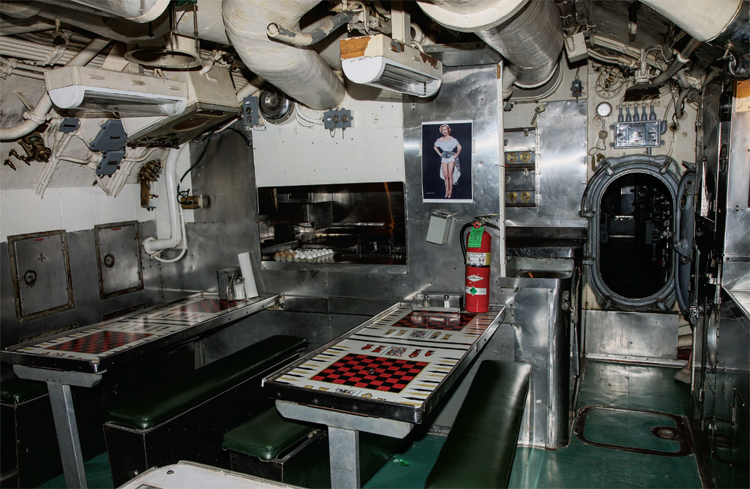
The mess deck of a typical Gato/Balao/Tench-class submarine. As the mess desk could only accommodate twenty-four men at a time, the crew ate in shifts. In between meal service, the mess deck became a multi-purpose room for a variety of things such as studying, listening to the radio, playing records or writing letters home to loved ones. (Paul and Loren Hannah)
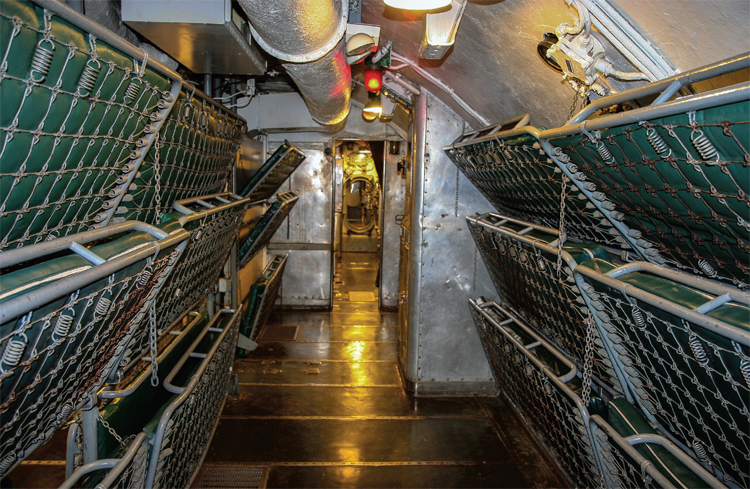
The enlisted men’s main berthing area occupied a space between the crew’s mess and the forward engine room and contained thirty-six bunks. Underneath the main berthing area was the aft battery compartment that contained 126 battery cells. The submarine’s forward battery compartment of another 126 battery cells was under the officers’ berthing area. (Paul and Loren Hannah)
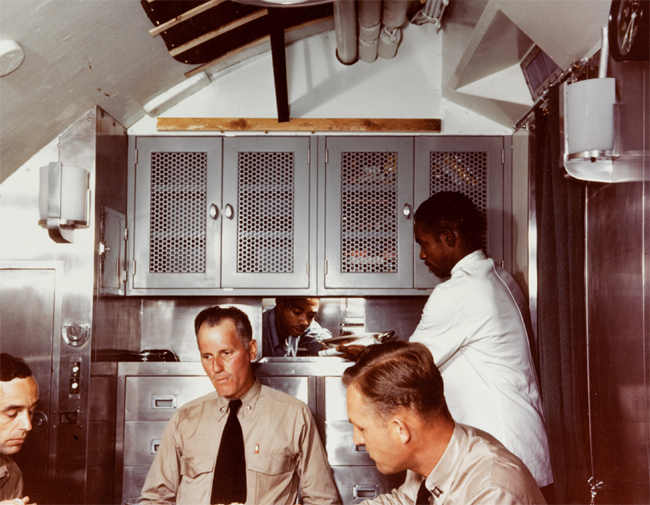
The officers on US Navy submarines as on surface warships ate in their messing area referred to as the wardroom. Senior officers typically included a lieutenant commander normally referred to as the ‘skipper’ and his executive officer nicknamed the ‘XO’ who also functioned as the boat’s navigation officer and was considered a future submarine commander in training. (US Navy)
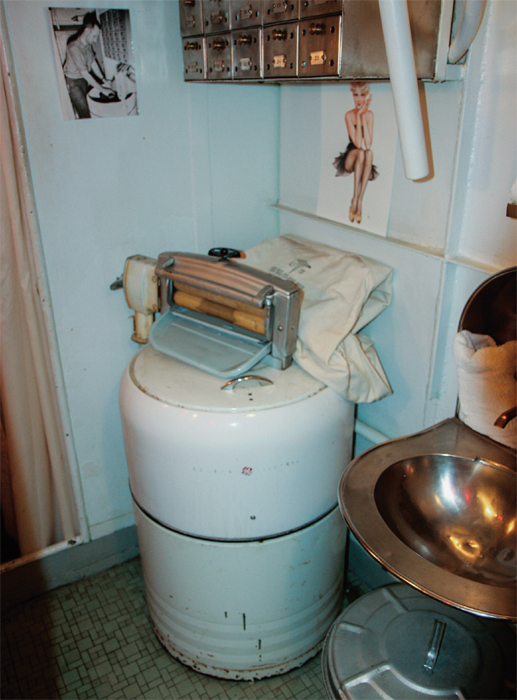
Unheard-of on any submarine of any other navy during the Second World War was the washing machine pictured here, along with the manually-turned dryer on top. Distilling equipment provided fresh water for the washing machine as well as for other functions such as the galley, showers and for topping up the 252 battery cells on the fleet-type submarines. (Paul and Loren Hannah)










































































